

C A R I B B E A N FREE AUGUST / SEPTEMBER 2023 NO. 328 THE BITTER
IS BACK! — See story on page 22 COURTESY OF BITTER END YACHT CLUB The Caribbean's Look at Sea & Shore
END

AUGUST / SEPTEMBER 20 23 CARIBBEAN COMPASS PAGE 2
by Michelle Slade
by Joyce Gauthier
Caribbean Compass

Caribbean Compass is published by Compass Publishing LLC of Connecticut, USA. www.caribbeancompass.com
Publisher | Dan Merton dan@caribbeancompass.com
Publisher Emeritus | Tom Hopman
Editor Emeritus | Sally Erdle
Editor | Elaine Lembo elaine@caribbeancompass.com
Executive Editor | Tad Richards tad@caribbeancompass.com

Art, Design & Production Berry Creative abby@berrycreativellc.com
Advertising & Administration Shellese Craigg shellese@caribbeancompass.com

AUGUST / SEPTEMBER 20 23 CARIBBEAN COMPASS PAGE 3 Contents AUGUST / SEPTEMBER 2023 • ISSUE 328 Reflections on Hugo
Donald M. Street Jr. Falmouth Freddy & The Cruising Kanes Chapter 2 by
On the Cover The Bitter End Yacht Club celebrates 50 years with a post-Hurricane Irma look. Photo courtesy of BEYC. For more about the reconstruction of the beloved resort, turn to the story by Michelle Slade, page 22. Hey Readers, Get Caribbean Compass By Email! Visit our website at caribbeancompass.com or just scan the QR code and enter your email address — it’s as easy as that! Featured 4 SSB Radio Stations 2023 6 Channel 16 8 Sounds+ Abbreviated 10 Business Briefs 11 Regattas & Rallies 16 Eco-News 30 Night Sky 33 Marine Life 36 Calendar of Events 36 Meridian Passage 37 Market Place 38 Island Poets 39 Classified Ads 39 Advertisers Index 7 24 Using Satellite Data to Navigate
Conover Cost Control While You Cruise
19 25 The Bitter End Is Back!
Galley Gadgets
22 28
by
Niamh McAnally
by Joan
by Lin Pardey
Game-Changing
Caribbean Compass welcomes submission of articles, news items and letters to the editor. See Writers’ Guidelines at Www.caribbeancompass.com/guidelines.htm. Send submissions to editor@caribbeancompass.com We support free speech! But the content of advertisements and articles are the sole responsibility of the advertiser or writer and Compass Publishing LLC accepts no responsibility for statements made therein. Articles and letters may be edited for length and clarity. We do not accept individual consumer complaints. ©2023 Compass Publishing LLC. All rights reserved. No reproduction, copy or transmission of this publication, except short excerpts for review purposes, may be made without written permission of Compass Publishing LLC. ISSN 1605 - 1998 COURTESY OF BEYC Peace returns to the anchorage at the Bitter End
Club, North Sound,
Islands
Yacht
Virgin Gorda, British Virgin
CARIBBEAN SSB RADIO WEATHER REPORTS SUMMER 2023

Note 1: Unless severe weather threatens, this net is not conducted on Sundays. When there are active tropical systems in the Atlantic, Marine Weather Center founded by Chris Parker (www.mwxc.com) runs a net at 2300 UTC / 1900 AST on 8137 USB.
Note 2: Please hail Marine Weather Center 15 minutes before the net so that Parker knows where to aim his antenna to reach you. This net is geared primarily to offshore Atlantic and Pacific passagemakers. After the Western Caribbean net Parker listens for additional boat traffic in the ESE and NE on 8137 and 12350 USB. For schedule updates see www.mwxc.com
SELECTED CARIBBEAN SHORTWAVE WEATHER REPORTS
4 Editor’s note: As he has in previous years, Ken Goodings shares his broadcast intel with Compass readers
Note 3: Emergency & priority traffic, safety and security; primarily for vessels making long ocean passages. Radio checks, float plans, telephone contact with family and friends, boat to boat relays, access to medical or mechanical professionals, internet searches and other assistance as required.
TIPS
In case of maritime emergency, there is a 24/7/365 24-hour Maritime Mobile Net (emergency, weather and cruiser assistance) 14300 kHz USB/Ham. Any vessel in distress may call in, even if not licenced for amateur radio, also known as ham radio.
Glenn (call sign KPK) listens for emergency/ humanitarian calls of any kind on his 1215 UTC morning SSCA net on 8104 kHz upper sideband. Similarly, Parker always listens for emergency traffic at the very beginning of every weather net on 4045, 8137 and 12350 kHz upper sideband.
HURRICANE WATCH NET - During severe tropical storm or hurricane activity, information can be found continuously on the Hurricane Watch Net on 14325 USB Ham and 3950 LSB Ham.
* Since November 3, 2008 several radiofax charts produced by the National Hurricane Center which are broadcast from New Orleans are based on information from different model run times. A 36-hour wind/wave chart has been added to the New Orleans broadcast. For full details visit www.nhc.noaa.gov/radiofax_transmission_changes.shtml
Frequencies (in kHz):
A) NMN, Chesapeake, 4426, 6501, 8764, 13089, 17314. Caribbean Sea approximately 25 minutes later. NMG, New Orleans, 4316, 8502,12788. Caribbean Sea approximately 25 minutes later.
B) 4316, 8502, 12788, 17144.5
C) 4369, 8788, 13110, 17362, 22804. Gulf of Mexico, Southwest North Atlantic, then Caribbean Sea
Note 1: An in-depth voice report followed by faxes and SSTV, except Sundays.
Note 2: Unless severe weather threatens, this net is not conducted on Sundays. When there are active Tropical systems in the Atlantic, Caribbean Weather (Chris) runs a Net at 2300 UTC / 1900 AST, on 8137, Voice, USB. For complete schedule and changes visit www.caribwx.com/ssb.html
Note 3: George comes on approximately 0710 with a weather synopsis, then moves to 7086 and at 0730 gives the complete Caribbean forecast including rebroadcasting WEFX.
• There are also a Bahamas Weather Net at 0700 EST on 4003, and a Puerto Rico/VI Weather Net at 1110 and 2310 UTC on 3930LSB.
• WWV has World Marine Storm Warnings (Voice) at 8 minutes after each hour, and Solar Flux information at 18 minutes after each hour on 2500, 5000, 10000, 15000, and 20000 AM.
• During hurricane activity, information can be found continuously on the Hurricane Watch Net on 14325 USB/ham.
*Atlantic Standard Time (AST) does not shift to Daylight Savings Time (DST) in the summer in Caribbean waters.
• Anyone, licensed or not, may legally operate on HAM frequencies in the event of a life-threatening emergency.
WWV Continuous Time and Frequency Standard Broadcast 2500, 5000, 10000, 15000, and 20000 (Switch to AM mode). WWV discontinued (January 2019) its World Marine Storm Warnings (voice) at 8 minutes after the hour. Solar flux information is still transmitted at 18 minutes after the hour.
WWV has resumed continuous time signal broadcasting on 25 MHz on an experimental basis. The broadcast consists of the normal WWV signal heard on all other WWV frequencies, at the same level of accuracy. Schedule is typically continuous. As an experimental broadcast, the 25 MHz signal, may be interrupted or suspended without notice.
A more complete schedule of East and West Coast nets is available at www.docksideradio.com
**
(in
New Orleans, 4316, 8502, 12788 USB
*** (Uncontrolled 1000-1200 UTC)
AUGUST / SEPTEMBER 20 23 CARIBBEAN COMPASS PAGE
UTC AST* STATION & REPORT DESCRIPTION FREQ TYPE MODE 0930 0530 NOAA Daily Offshore Forecast Voice USB ** 1000 0600 Daily Caribbean Weather 6215 *** USB 1000 0600 Eastern Caribbean Weather (Parker) 4045 & 8137 USB (Note
1030 0630 Trinidad Emergency Net 3855 LSB/Ham 1030 0630 Caribbean Emergency & Weather Net 3815 LSB/Ham 1030 0630 Bahamas Weather (Parker) 4045 & 8137 USB (Note 1) 1100 0700 Caribbean Net (Mon-Sat) 7250 LSB/Ham 1120 UTC Bahamas Weather C6AGG Carolyn Wardle 7096 & 3696 LSB/Ham 1130 0730 US East Coast, Western Atlantic N&W of Bermuda Weather (Parker) 8137 &12350 USB (Note 1) 1145 UTC Waterway Cruising Club 7268 LSB 1200 0800 Coconut Telegraph 4060 USB (Mon-Sat) 1215 0815 KPK Cruising Safety (Sponsor SSCA) 8104 USB 1230 0830 Eastern Caribbean Weather (Parker) 8137 & 12350 USB (Note 1 1330 0830 (local time) Panama Connection 8107 USB 1230 0830 Cruzheimers Net 8152**** USB 1300 0900 Western Carib Weather (Parker) 0700 hours local time in Western Carib 8137 & 12350 USB (Note 1) 1330 UTC Panama Connection Net 8107 & 8167 USB 1400 UTC Northwest Caribbean Net 6209 USB 1530 1130 NOAA Daily Offshore Forecast Voice USB** 2030 1630 Caribbean Cocktail & Weather Net 7086 LSB/Ham 2100 1700 Doo-Dah Net 8152 USB 2110 1710 Transatlantic Cruiser’s Net (SSCA) 12350 USB Net (Note 3) 2130 1730 NOAA Offshore Forecast Voice USB** 2200 1800 Caribbean and Atlantic Weather (Parker) 8137 & 12350 USB
1 and 2) 2230 1830 Caribbean Emergency & Weather Net 3815 LSB/Ham
1)
(Notes
USB
NOAA offshore stations
kHz): NMN, Chesapeake, 4426, 6501, 8764, 13089, 17314
NMG,
or 8164
**** Primary Frequency—Secondary 8146
UTC AST STATION & REPORT DESCRIPTION FREQ TYPE MODE 0600 0200 NMG Broadcast B Wefax* USB 0930 0530 Offshore Forecast A Voice USB 1030 0630 Trinidad Emergency Net 9Z4CP (Eric) 3855 Voice LSB/ham 1030 0630 Carib. Emergency & Weather Net 3815 Voice LSB/ham 1100 0700 Caribbean Weather (Chris) 8137 Voice USB (Note 2) 1100 0700 Caribbean Maritime Mobile Net 7250 Voice LSB/ham (Note 3) 1130 0730 KP2G Caribbean Weather Net (George) 7086 Voice LSB/ham (Note 1) 1200 0800 NMG Broadcast B Wefax* USB 1230 0830 Caribbean Weather (Chris) 8104 Voice USB (Note 2) 1300 0900 Caribbean Sea (WLO) C Voice USB 1330 0930 Caribbean Weather (Chris) 12350 Voice USB (Note 2) 1530 1130 Offshore Forecast A Voice USB 1800 1400 Caribbean Sea (WLO) C Voice USB 1800 1400 NMG Broadcast B Wefax* USB 2000 1600 Southbound II (Herb) 12359 Voice USB 2030 1630 Carib. Cocktail & Weather Net (George) 7086 Voice LSB/ham 2130 1730 Offshore Forecast A Voice USB 2235 1835 Caribbean Emergency & Weather Net 3815 Voice LSB/ham 0000 2000 Caribbean Sea (WLO) C Voice USB 0000 2000 NMG Broadcast B Wefax* USB 0330 2330 Offshore Forecast A Voice USB
SELECTED CRUISERS’ VHF NETS St. Martin/Maarten 0730 VHF 14 Monday-Saturday English Harbour 0900 VHF 68/06 Daily Grenada 0730 VHF 68 Monday-Saturday Chaguaramas 0800 VHF 68 Monday-Sunday Porlamar 0800 VHF 72 Monday-Saturday Puerto La Cruz 0745 VHF 72 Monday-Saturday Thanks to William Mills of Toucan I, Teri Rothbauer (and the Ghost) of FREE,
Richardson of Overstreet, Bill Campbell of Alcheringa II, and the Pompas of Second Millennium for information, which was correct to the best of our knowledge as this issue of Compass went to press.
Dave
ILLUSTRATION BY GUY DEAN

AUGUST / SEPTEMBER 20 23 CARIBBEAN COMPASS PAGE 5
Channel 16
New Binoculars Installed at Jack Boy Hill, Montserrat
The Montserrat Tourism Division has recently installed new binoculars, with powerful zoom capabilities and crystal-clear lenses, at the Jack Boy Hill viewing facility, offering nature and volcano enthusiasts an enhanced view of the Soufrière Hills volcano, the buried WH Bramble Airport, lush vegetation, and the neighboring island of Guadeloupe.

The Montserrat Volcano Observatory and Garibaldi Hill Viewing facilities will also have binoculars installed.
“We are excited to offer our visitors a new way to experience Montserrat’s natural wonders, including the Soufrière Hills volcano, with the installation of these new binoculars,” said Rosetta West Gerald, Montserrat tourism division director. "We believe that this will enhance our visitors’ experiences and encourage them to learn more about the island’s fascinating geological history.”
Besides new binoculars, the Jack Boy Hill viewing facility offers comfortable seating, picnic tables and a barbeque grill station. The facility is open daily for viewing; visitors are advised to keep the facility tidy and close the gates upon entry and departure.
Private group events at the Jack Boy Hill facility can be arranged though the Montserrat Tourism Division (1 664 491 4703; info@ montserrattourism.ms).
VIPCA to Launch First Virgin Islands Boating Exhibition




The inaugural Virgin Islands Boating Exhibition (VIBE) will take place January 12-15, 2024, at IGY’s Yacht Haven Grande Marina St. Thomas. The event will showcase cutting-edge sail and power yachts. VIBE is organized by the Virgin Islands Professional Charter Association (VIPCA), which supports the territory’s charter industry and also puts on the USVI Charter Yacht Show, which in 2023 runs from November 11-14.
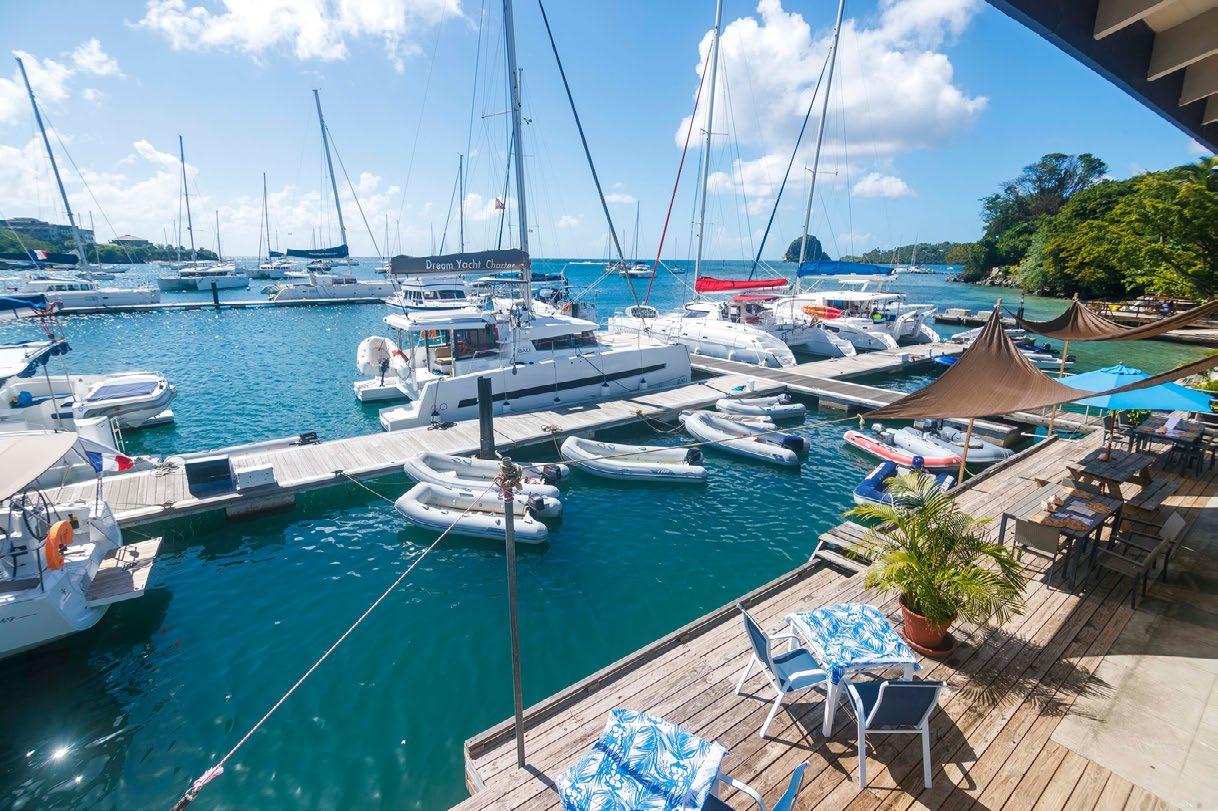
Sint Maarten Yacht Club Program Aids Differently Abled

The Sint Maarten Yacht Club is proud to announce the launch of a
















“Sailability” program, a program for differently abled youth and adults, building on the belief that for those with a physical or mental disability, sports are important, not only as daytime activity but also to build selfconfidence and focus. Programs are individually designed based on each student’s individual capabilities.
With financing by the government of the Netherlands via the Sint Maarten Trust Fund, the Resources for Community Resilience (R4CR) program has purchased an RS Venture Connect, a self-righting keelboat with a lifting bulb keel for exceptional security and seaworthiness, and "plug & play" para sailing equipment options, which allow it to be set up for almost any disability — and changed between sessions as required. The funds make it possible to run the program for one year.
For more information, contact SMYC manager Saskia Revelman (Saskia@smyc.com).
Hemingway International Yacht Club Anniversary
The Hemingway International Yacht Club of Cuba celebrated its 31st anniversary in May 2023. The club has faced hard times, but is grateful for the support of nautical institutions from around the world. Commodore Escrich emphasized the bonds of friendship and collaboration which the club has maintained as an embassy of friendship among those who love the sea and recreational sailing.
The club’s anniversary message concluded with “thank you to the more than 3,600 members from 73 countries who have supported us during these 31 years.”
Fajardo’s Marina Puerto Chico Wins $1M+ Infrastructure Grant Marina Puerto Chico in Fajardo, in partnership with the Puerto Rico Department of Natural and Environmental Resources (DNER), has secured a grant of $1,137,000 to further the development of its transient marina project. The funding is part of the Boating Infrastructure Grant (BIG) program by the U.S. Fish and Wildlife Service, which has distributed more than $20 million this year. The BIG initiative supports states and U.S. territories in developing, renovating and maintaining marinas and other boating facilities to encourage outdoor recreation.
Marina Puerto Chico applied for the grant and committed to providing an additional $968,582. In January, Marlon Mellado, the CEO of Grand Caribbean Marinas, stated that the estimated cost of the project is $4.5 million. The grant will support the construction of 41 slips, including 19 transient slips. The construction of the docks and the floating wave attenuator is expected to help mitigate the impact of waves and storms.
—Continued on page 8
AUGUST / SEPTEMBER 20 23 CARIBBEAN COMPASS PAGE 6 Fuel Dock 24 hour Security Port of Entry Customs & Immigration Office - 9am to 6pm Electricity 110V/220v & Water Complimentary Wifi Laundry Service Supermarket & Boutique Cafe Soleil & Flowt Beach Bar The Loft Restaurant and Bar Indigo Dive Shop Swimming Pool Beautifully Designed Hotel Rooms Marina: VHF 16 or 68 Email: info@bluelagoonsvg.com 784.458.4308 Call:
An enhanced view of the Soufrière Hills volcano
Cutting edge sail and power yachts on exhibit
Venture Connect sailboat
Marina Puerto Chico in Fajardo
PHOTO
COURTESY OF MONTSERRAT TOURISM DIVISION PHOTO COURTESY OF VIPCA PHOTO COURTESY OF SMYC PHOTO COURTESY OF MARINA PUERTO CHICO
Hurricane Season and Reflections on Hugo
by Donald M. Street Jr.
For anyone who followed the track of the NOAA announcements of the position, speed of advance and direction of Hugo, it was obvious a couple of days before it hit in September 1989 that Hurricane Alley — Anguilla to Puerto Rico
— was going to take a major hit.
a large number of boats fled to the so-called hurricane holes: Coral Bay, St. John, USVI; Paraquita Lagoon, Tortola, BVI; Ensenada Honda, Culebra, off Puerto Rico. Some hunkered down in their marinas.
Bill Skol, owner of Tradition, the 48-foot traditional gaff-rigged schooner, decided to go to sea. He headed south 48 hours before Hugo was due to hit Fajardo, Puerto Rico. He couldn’t secure a crew. Everyone insisted he was committing suicide to go to sea with a hurricane approaching. He took off 48 hours before Hugo was predicted to hit. He set the forestaysail, foresail and storm trysail, motor sailing south at about 6 knots. When the hurricane hit Fajardo, he was roughly 300 miles south. He turned around and headed north. He had no problem with wind, no more than 30 knots. Sea conditions were easy to handle, a long, big easy swell.
He arrived back in Fajardo to discover nothing but death and destruction. Amazingly he found the dinghy that he had to leave behind, up a tree, undamaged.

Boats in the so-called hurricane holes suffered catastrophic losses. In the vast majority of the marinas, the floats came adrift, cleats came out of docks, boats suffered major damage and a large number sank. Regarding boats stored ashore, it was not a case of how many blew out of their jack stands, rather, the very few numbers that survived the hurricane in an upright position!
The one exception to the above was Marina Puerto del Rey, with about a thousand boats; fewer than 10 percent sank. At the storage facility ashore, none of the boats suffered any major damage.
I reported this and recommended that sailors keep track of hurricanes and follow Skol’s action, departing 48 hours before the hurricane is predicted to hit. Head south or southwest, sailing, motor sailing or motoring. In 24 hours, the boat will be 144 miles south of the hurricane track, and 48 hours roughly 300 miles south of the center of the hurricane. This distance will put the boat well clear of any dangerous wind velocities and dangerous sea conditions.
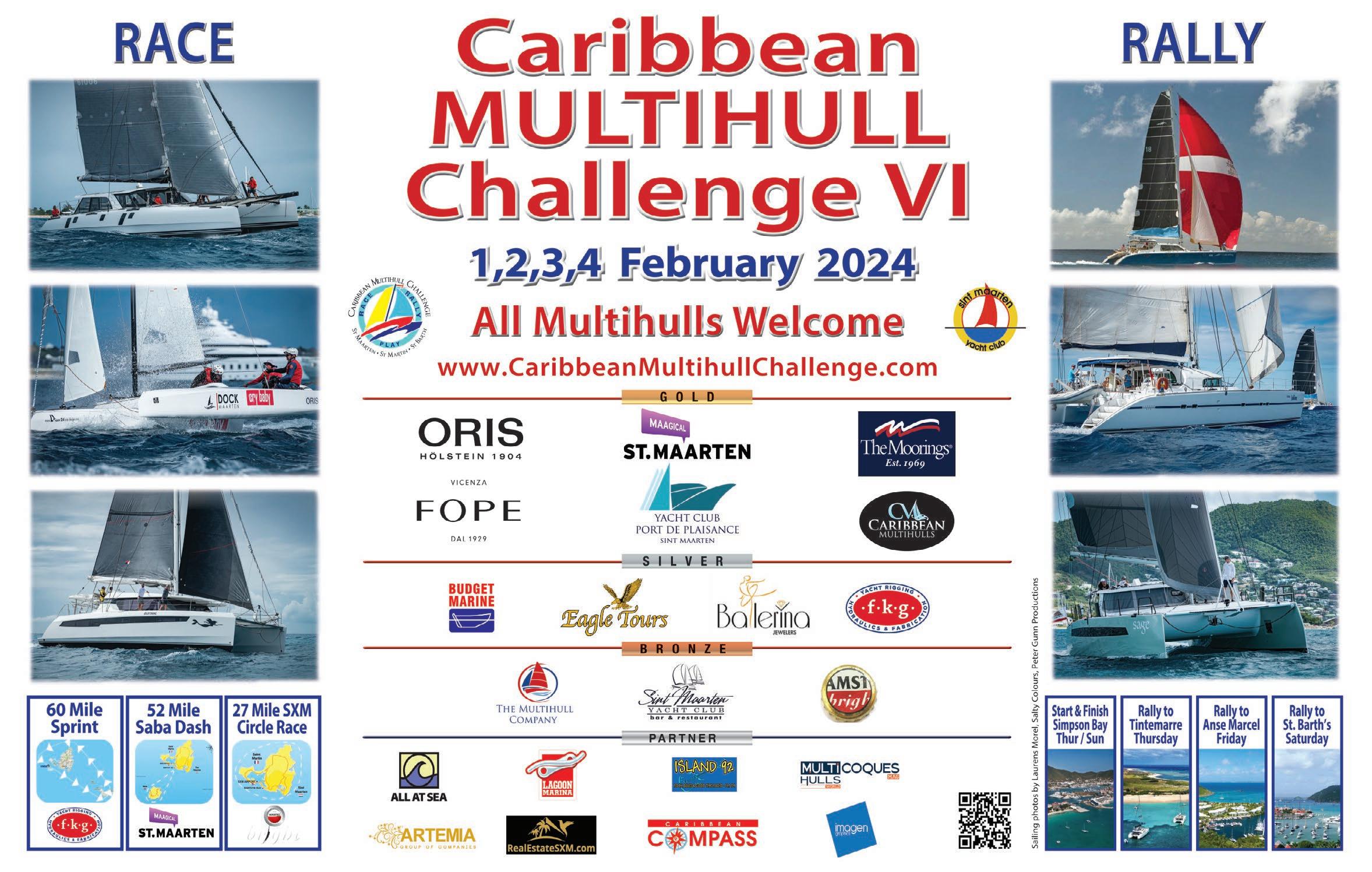
The reaction to the story I wrote in November 1989 was interesting. Some of the letters said that I was insane to recommend departing 48 hours before the hurricane hit. A few agreed with my advice.
At my website, read the hurricane section, which was written after I studied the NOAA hurricane data. It showed the track of all hurricanes and named tropical storms from 1871 to 1998. Now, 34 years after I first wrote “Reflections on Hugo,” especially after doing the survey and tracking hurricanes, I feel that Bill Skol was correct and sailors today should do the same thing.
A version of this article originally appeared in November 1989. The author advises mariners to check NOAA’s National Hurricane Center daily at this time of year and consult his website (www.street-iolaire. com) often.
AUGUST / SEPTEMBER 20 23 CARIBBEAN COMPASS PAGE 7 STREET’S REPORT
A sailboat lies on its port side in Puerto Rico after it ran aground during Hurricane Hugo in September 1989.
PHOTO COURTESY OF U.S. NATIONAL ARCHIVES
SOUNDS+ ABBREVIATED
Continued from page 6
SSCA, Coast Guard, Commercial Ship Aid Vessel
BY TAD RICHARDS
Spicemas!
The Rolling Stones will tell you that Jumping Jack Flash was born in a crossfire hurricane, but if he had been, even he would know to stay out of them in the future. So not much Sounds+ action in August and September, but we’ll come howling back in the October/November Compass.
Meanwhile, here’s a tip. August 1 is Jambalasee Festival, a celebration of Grenada’s Jab Jab culture—the culture of the celebration of freedom, kicking off Grenada’s two-week festival known as Spicemas, growing from the African traditions of the enslaved people, bursting forth. This is Grenada celebrating itself, its tradition as a spice island, its history and culture and music. (spicemasgrenada.com/events).
Other carnivals worth checking out: The Crop Over Festival, Barbados’ annual cultural celebration of harvest and history, starting on August 1, culminating in the Grand Kadooment (Bajan for large party) on August 7.
Antigua Carnival, August 7-8. A T-shirt parade held the week before is bound to involve some of the participants getting wet. Belize Carnival, September 9, a tradition since 1975, features theatrical music, dance, and costumes.

The Norden Synergy tank ship M/T La Digue, alerted by the Seven Seas Cruising Association (SSCA) communication network and the U.S. Coast Guard, conducted a refueling of the M/V Cross Winds south of the Turks & Caicos in May 2023. Crew of the Cross Winds reported contaminated fuel aboard, and the commercial vessel was enlisted to assist. An offshore fuel transfer, a difficult task, was necessary. The afflicted vessel then made safe harbor in Luperon, Dominican Republic.
The initial call for aid was picked up by Denise Simpson, SSCA station host for the Dominican Republic. Although the boat wasn’t a member vessel of SSCA, the organization's policy is to respond promptly in all emergency situations.

Work by Compass contributor Is Recognized
A nonfiction work by author and Compass contributor Niamh McAnally was shortlisted for the Vikki Orvice Award for New Women’s Sports Writing in the 2023 Sports Book Awards in association with The Sunday Times. Flares Up tells the true story of why two middle-aged men rowed a 20-ft wooden boat 3,000 nautical miles across the Atlantic Ocean and how it affected their families.

McAnally’s stories are inspired by her travels on land and by sea. She and her husband, Gary Krieger, spent six years sailing through the Bahamas and the Caribbean islands. Turn to page 24 of this issue for the second installment of her latest work, Falmouth Freddy and the Cruising Kanes.

SSCA Announces New Management Team
Seven Seas Cruising Association (SSCA) announces its new SSCA Homebase Management Team, ACCLAIM: Membership Coordinator Nicole Economou and Association Manager Yvonne Kriss, dedicated to the efficient support into SSCA's growing outreach into cruisers' lifestyle. SSCA has upgraded to a modern phone system. Also added is SSCA Partner, St. Brendan’s Isle, for the Florida business address.
SSCA is located at 411 Walnut Street #17000, Green Cove Spring, FL 32043-3443. Phone:(754) 702-5068, and email office@ssca.org.
AUGUST / SEPTEMBER 20 23 CARIBBEAN COMPASS PAGE 8
DIGITAL PAINTING
A fuel transfer offshore is a real challenge.
PHOTO COURTESY OF M/T LADIGUE
Niamh McAnally and husband, Gary Krieger, at the awards ceremony in London
•The most experienced, most professional yard in the Caribbean with the most comprehensive list of onsite marine services and contractors – FACT!!

•At the best prices – FACT!!
• FREE water - FREE fully functional WIFI
•All this in the least extreme weather zone in the region – FACT!!
Treat your beautiful boat to the best. You know she deserves it! CONTACT US TO LEARN ABOUT OUR SUBSTANTIAL DISCOUNT SPECIALS.
AUGUST / SEPTEMBER 20 23 CARIBBEAN COMPASS PAGE 9 YACHT
Chaguaramas Bay, Trinidad VHF CHANNEL 69 160 Ton Marine Travelift - Maximum Beam 31 ft No Forestay Removal On Most Yachts Below 60 ft Fully stocked chandlery, hotel and restaurant on site P.O. Box 3168 Carenage Trinidad • Tel (868) 235 4PYS (797) reservations@peakeyachts.com • www.peakeyachts.com
SERVICES
Parts & Power Celebrates 50th Anniversary
Parts & Power held an open house at its Tortola, BVI, facility at the end of June to celebrate its 50th anniversary. The event was sponsored by Perkins, Northern Lights, JCB, Eaton, Kubota and Dometic. Don Schutte from Northern Lights, Joe Mislan from Eaton, and Erick Montero from JCB attended and met with customers. Manufacturer displays were set up for Perkins, Kubota and Dometic.
Northern Lights Sales Manager Don Schutte, CFO Barbara Gerker, GM Gavin Dooley, Lyndon Vandenburg of the Moorings/Sunsail, Shawina Jacobs and Shania Bridgelall from Parts & Power.
Northern Lights donated the grand prize for the raffle, a 150 quart, 7-day ice cooler. Mislan set up a demonstration of three types of uninterruptable power supplies, surge protection equipment and “smart” wiring devices such as light switches and wall outlets. Montero displayed two JCB telescoping forklifts. Schutte displayed Northern Lights generators and hosted the Northern Lights Popcorn Friday.
The ceremony was attended by Parts & Power customers, business leaders and government officials. Among the attendees were Dr. the Honourable Orlando Smith; Honourable Kye Rhymer; Janet Oliver, executive director of the BVI Charter Yacht Society; and Andrew Ball, chairperson of the Marine Association of the BVI. Others included Dr. the Honourable Natalio Wheatley, Honourable Ronnie Skelton, Honourable Myron Walwyn and Honourable Mitch Turnbull.

Antigua Girls in World’s Toughest Row; Budget Marine Is Sponsor
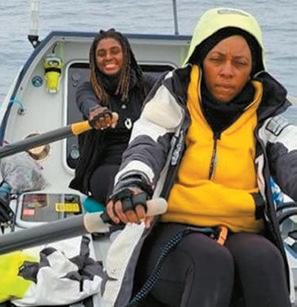
When Team Antigua Atlantic Rowers arrived home in second place on January 13, 2018, the challenge was issued for an all-female team from Antigua and Barbuda. Several women answered the call. After months of training and preparation, the Team Antigua Island Girls now row the ocean, all carrying the mantle for the country. They are almost halfway in the event, which started on June 12.
Pacific Challenge 2023 is called The World’s Toughest Row. It is an extreme race of endurance, where individuals from across the globe test themselves against Mother Nature by rowing 2,800 miles across the Pacific Ocean, from Monterey Bay in California to Nawiliwili Bay in Hawaii. This challenging and technical route offers a full range of tests for the human mind and body.
Sleep deprivation, hallucinations, hunger, stiff and aching bodies are balanced by camaraderie, achievement, self-discovery and pride, and by sighting incredible marine life, witnessing the breaking of new days
and sunsets that cannot be viewed from land.
Team Antigua Island Girls have set their sights on being the top female contenders and among the top five overall. They have been put through their paces on the water by coach Eli Fuller and in the gym by personal trainers, including team member Kevinia Francis.
Budget Marine is one of the main sponsors of Team Antigua Island Girls on their journey and is proud to contribute.
Take a Day Trip to Jost Van Dyke with Dolphin Water Taxi
Express transportation from St. Thomas, United States Virgin Islands, to the Bitter End Yacht Club and other destinations in the British Virgin Islands is offered by Dolphin Water Taxi. In business more than 15 years, the company's fleet of 12 vessels quickly move passengers in comfort and safety from baggage claim through customs and immigration. Boats have enclosed cabins; Dolphin also operates a cafe/bar at West End, Tortola. Full and half-day outings are also available, including to scenic White Bay, Jost Van Dyke, B.V.I. Trips for a minimum eight passengers are available out of Red Hook, St. Thomas, or Cruz Bay, St. John. Departures shove off at 8:30 a.m or 9:30 a.m. and return by 3:30 p.m. Rate for eight is $1,520. Dolphin keeps a list for partial parties of fewer than eight for a combined outing. Find Dolphin at www.dolphinshuttle.com; dolphinshuttle@gmail.com; 340-774-2628.
Horizon Yachts, Local and International
Horizon Yachts Grenada, headed by James Pascall, specializes in providing mechanical engineering, project management, and guardianage services, as well as an array of services to cater to the unique needs and requirements of each yacht owner. Among these are marine engineering and mechanical support, yacht maintenance, outboard troubleshooting, launching & hauling, decommissioning & re-commissioning, rigging, bimini installation, hurricane preparation, specialist parts procurement.
Partner Horizon Yachts International is a brokerage service for new and used yachts, offering the personalized service of a small company and the global reach to assure that a yacht offered for sale will be seen by many potential buyers. Its status with Horizon Yachts Grenada ensures the company can offer a seamless journey into boat ownership.
Gary Haynes, yacht sales manager, has years of experience in yacht systems, racing, cruising, and sales and marketing; Jacqui Pascall, sales associate, has a wealth of knowledge of the sailing industry. Steve Ellyatt, representative in Carriacou, is also an expert in the marine industry. The team and office are at Clarke’s Court Boatyard & Marina. (1 904 638 2373;info@horizonstvincent.com).

AUGUST / SEPTEMBER 20 23 CARIBBEAN COMPASS PAGE 10 • Yacht Concierge 24/24 - 7/7 • Electronic Clearance via Email • 4G/LTE & TVRO products & services • Project Management: Haul-Out, Maintenance • Gourmet provisions • Medical Turnkey Assistance & MEDEVAC Cell : +596 696 45 89 75 / Office : + 596 596 52 14 28 / mail : douglas@yachtservices.fr www.douglasyachtservices.fr Service Team « A to Z » SERVICE AGENT BUSINESS BRIEFS
PHOTO BY TONY TUCKETT PHOTO BY @WORLDSTOUGHESTROW
REGATTAS & RALLIES
54th Antigua Sailing Week
The 2023 Antigua Sailing Week on April 30-May 6 attracted boats and crew from over 20 nations, with sailors competing from six continents. Chris and Caroline Body, racing J/122 El Ocaso, lifted the Lord Nelson Trophy as the overall winners of the event. The team from the Royal Southern Yacht Club in the UK is Chris and Caroline with their two daughters, Jessica and Annabelle Body.

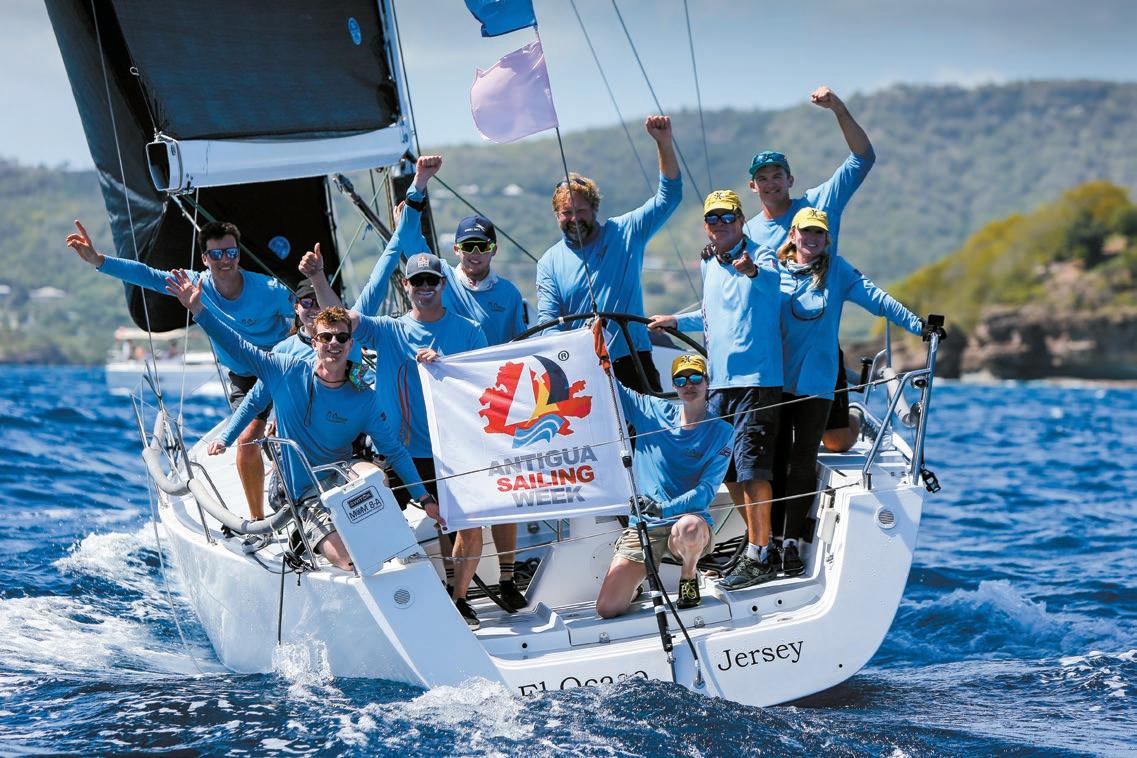
Built in 1996, the Frers Swan 48 Assuage is proof that a boat that is nearly 30 years old can win at Antigua Sailing Week. Chris Woods has beautifully restored Assuage and sails her with family and friends.

El Ocaso was the winner of CSA 2, lifting the English Harbour Rum Trophy and the Fletcher Trophy for the Best British Yacht. Second in CSA
2, winning the Mollihawk Trophy, was Pamala Baldwin’s Liquid (ANT). Third was Sir Richard Matthews’ Holding Pattern (GBR).
The winner of CSA Multihull, lifting the A&F Sails Cup, was Guy Chester’s Ocean Tribute (AUS). Second, winning the Commander’s Cup, was Michel Larroche’s Tribe (FRA) and third was Fedrik Moe’s Moementum (JAM).
The winner of CSA 4 was a team from Sag Harbor, New York on J/120 J-Aguar (USA), winning the Sanhall Trading Cup. Colin Baldwin’s Live Love Antigua (Sete Maris) (GBR) was second in class winning the Delta Cup and Patrick Holloran’s Caipirinha (GBR) was third.
“I am completely flummoxed!” said Chris. “These regattas don’t just happen, they take a monumental amount of effort, and I know every competitor really appreciates the effort to make this such a spectacular event."
Second overall, winning the Peter Deeth Trophy and winning CSA 1 for the Curtain Bluff Trophy, was John Evans & Trey Sheehan’s Hooligan (USA), scoring eleven race wins. Second in CSA 1 was Daniel Gribble & Dean Ziehl’s Prevail (USA), lifting the Global Bank Trophy with a crew from the Balboa Yacht Club, California. Third was Karl Pisec’s Black Pearl (AUT) with a crew from the YC Porto Rotondo, Italy.
The winner of CSA 5, lifting the Governor General Cup, was Tristan Marmousez’s GFA Caraïbes (FRA). Antigua Sailing Week was unfinished business for GFA Caraïbes – La Morrigane, which was second last year by just two points to NSA Spirit.
“It was very nice to win this year to make up for last year,” said Marmousez. “This year we had a lot of current and very complicated conditions. We are so happy as we have won in Grenada, St. Maarten, and now in Antigua. We cannot wait for next year!”
The overall winner of the Dream Yacht Charter Bareboat Class was Coleman Garvey’s KH+P Nolde (IRL) winning the Dream Yacht Charter Trophy and the AHTA CUP for first in Bareboat 2. Second overall, winning the LIAT Caribbean Airline Cup and first in Bareboat 1 for the Antigua Slipway Trophy, was Alfred Geisser’s KH+P Botero (SUI). John Howell & Paul Newell, racing BESRA in Bareboat 1, won the Royal Southern Challenge Yacht Club Shield Trophy.
Antigua Sailing Week introduced two new sailing events this year, Wingfoil and the RS Elite Class.

—Continued on next page
Third overall and winner of CSA 4 was Chris Woods’ Assuage (GBR) lifting the Catamaran Marina Cup and the Chippy Fine Yacht Woodwork Trophy. Second in class was Andy Middleton’s EH01 (GBR) winning the Gitane IV Cup and the Hinkley Cup for Best Charter Yacht. Third was David Crum’s Quintessence 3 (USA). Katy Campbell’s Panacea (CAN) was the winner of the Holtman Cup for the Best Women’s Crew at Antigua Sailing Week.
AUGUST / SEPTEMBER 20 23 CARIBBEAN COMPASS PAGE 11
El Ocaso and crew. Chris & Caroline Body’s J/122 El Ocaso won the Lord Nelson Trophy, CSA 2 and Best British Yacht at Antigua Sailing Week.
Panacea and crew. Katy Campbell’s Panacea was the winner of the Holtman Cup for the Best Women’s Crew at Antigua Sailing Week.
Hooligan and crew
Foilers
PHOTO BY PAUL WYETH/PWPICTURES.COM
PHOTO BY PAUL WYETH/PWPICTURES.COM
PHOTO BY PAUL WYETH/PWPICTURES.COM
PHOTO BY WILLIAM SIMPSON
The inaugural Antigua Wingfoil Championship Pro Class was especially intense, with local wingfoiler Idani Edwards and Martinique wingfoiler Anthony Smith battling for first place. Smith won the final and deciding race by just two minutes from Edwards.

Back in February, Antiguan Optimist Champion Emily Gaillard became the youngest competitor to complete the gruelling RORC Caribbean 600. At Antigua Sailing Week, Emily skippered Outdoor World Yamaha (ANT) to victory in the RS Elite Class, with a crew of Shannoy Malone and Alistair Knoblauch. All three are just 15 years of age and lifted the One Design Trophy as well as the Youth Trophy for Antigua Sailing Week. Second in the RS Elite Class was Paul Deeth’s Da Boom (ANT) and third was Robbie Ferron’s Oozlumbird
Club Class 1 and the American Airlines Trophy went to Reggie Williams’ Legacy (TRI) after a close battle with Mathias Maus’ Alpha Centauri of London (GER). Third was Moonflower 3 (GBR) with an all-women team skippered by Chloe Need. The Soverel 43 Legacy is part of the history of Antigua Sailing Week; “Legacy” is the only racing mark of the course, named after the boat.

Club Class 2 went to Geoffrey Pidduck’s Hightide (ANT), lifting the West Indies Publishing Cup by just two points from the teenage team racing Absolute Properties (BP), skippered by Carrack Jones, which won the Admiral’s Inn Trophy. Third was the developer of the variable scoring system used at Antigua Sailing Week, Sandy Mair, racing Cricket (ANT). Sandy was also announced as the recipient of the Jan Santos Trophy in honour of individuals who have shown dedication to Antigua Sailing Week over an extended period. Sailing Week returns in 2024 from April 27 – May 3.
Antigua to Bermuda Race

Tod Slyngstad’s HH 66 catamaran Nemo was the first to reach the island’s shores in this year’s Antigua Bermuda Race, crossing the finish line off St. George’s on May 13, more than five-and-a-half hours ahead of Stefan Jentzsch’s Botin 56 Black Pearl to claim first place in the in IRC and CSA classifications.

The final reckoning had Nemo finishing first in the CSA Multihull division, with Black Pearl taking top honors in the CSA Monohull and IRC divisions. Raymond Rhinelander’s J/133 Bella J took second place honors in CSA Monohull, with Kevin and Sean McLaughlin’s X55 Rye taking third. Rye and Bella J flipflopped positions in the IRC.
—Continued on next page

AUGUST / SEPTEMBER 20 23 CARIBBEAN COMPASS PAGE 12 Continued from previous page
Cool Runnings III, Gold Coast 65 Photo by: Alec Drayton
Foilers and sailboats
Fleet racing
PHOTO BY WILLIAM SIMPSON
PHOTO BY PAUL WYETH/PWPICTURES.COM
Continued from previous page
BVI Dinghy Championships







Many first-timers were among the sailors who took to the water on May 13, adding a buzz of excitement to the 2023 BVI Dinghy Championships.



The racecourse was set in the Sir Francis Drake Channel. The ILCAs and RS Fevas raced a triangular course, while the Optimists took a windward leeward course, and the foilers figured it out on the fly.

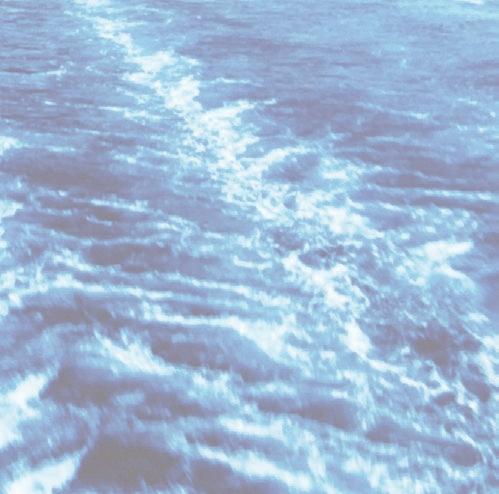

The six Optimists, skippered by sailors aged between eight and 13, sailed a total of seven races. Lochlan Geyser, Piper Bailey and James Davis all won races, with Dottie Knight, Jake Richardson and Phoenix Steer all finishing in a top three position.
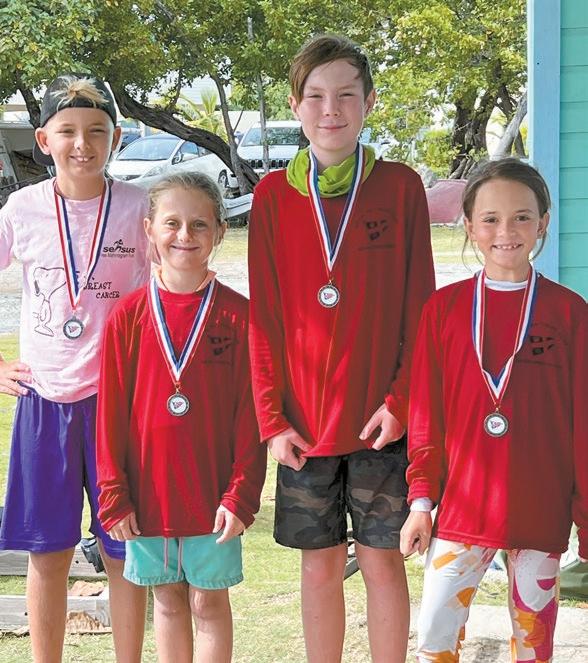
Other members of the youth sailing program were competing in the RS Feva class, which saw a mixture of adults and youngsters. The only youth team, Aerin Westlake and Maggie Nolan, put in an impressive performance, finishing third. Rhiannon Davis, sailing with son Ioan, finished second overall. Mia Armstrong, 13 year old, with her mother Cate as crew, claimed a clean sweep of first place finishes to take the title.
In the ILCA4 (Laser 4.7) fleet, Marentia de Villiers won the first three races and finished second in the fourth to take the title ahead of Bijorn Bullock, another sailor racing in his first regatta. He won the fourth race and took second place in the other three, finishing second overall.
The ILCA7 (Laser) class had only two entries and Samuel Allen took a clean sweep of race wins. Aaron Gardner finished in second place.

Many Laser fleet competitors have taken up wing foiling, so a foiling event has been added to the championships. With three races sailed, wins in the first two were enough for Rusty Henderson to take first overall. Colin Rathbun finished in second place and Chris Haycraft in third.
2023 Island Water World Mini Bucket



Twelve Team SXM sailors, accompanied by coach Sam Peeks, participated in St. Barths’ Mini Bucket regatta from May 19-22: two days of training and two days of racing. They faced rough seas, high winds and stiff competition from sailors from St. Barths, St. Martin and Guadeloupe.

—Continued on next page



AUGUST / SEPTEMBER 20 23 CARIBBEAN COMPASS PAGE 13
Foiler class, BVI Dinghy Championships
Optimists Phoenix Steer, Dottie Knight, Jake Richardson and Piper Bailey.
PHOTO COURTESY OF RBVIYC
PHOTO COURTESY OF RBVIYC
Ready for race start
The Sint Maarten Yacht Club was well represented in the ILCA class, a total of 20 boats competed against each other. These SXM sailors competed in this class: Rio Stomp with an overall position in 7th place, Frits Bus in 8th place, Emma Lennox in 11th place, Melina de Vries in 16th place and Maya Speetjens in 18th place. Emma Lennox took home the prize for the best female in the ILCA class.
In the Optimist class of 21 competitors, Nathan Sheppard was best SXM sailor in this class with a 9th place finish — he also claimed 3rd in the Benjamin Class (a class for the younger sailors). Harper Treadwell came in 13th.

Caribbean Sailing Association Holds Annual Meeting
More than 25 members of the Caribbean Sailing Association, representing over 10 different islands, convened on May 30 for the annual general meeting at Antigua Yacht Club.
“It became the theme of our conference that this year we have to take a different approach,” said Michele Korteweg, CSA president. “We need to stop focusing solely on our own programs and broaden our horizons to analyze trends and developments so we can be proactive in an environment of constant change and challenges. The CSA brings the region together and has made it a very strong entity.”
Board members are president Michele Korteweg (SXM), treasurer Steve Kern (BAR), board director Rana Jamila-Lewis (ANT), vice president Tamsin Rand (BVI), vice president Saskia Revelman (SXM), vice president Jaime Torres (USA), vice president Brian Sylvester (GREN), vice president Bruno Kancel (GLP), chief measurer Bastien Pouthier (TTO), past president Alison Sly-Adams (ANT).
The conference focused on further developing regattas and sailing programs in the Caribbean. Topics included race management, international trends, foiling in the Caribbean, marketing and inclusion.
A separate training session was held by the CSA measurers, including potential new measurers from Barbados and Antigua, as the Caribbean team recognized the importance of adding new talent. Information was shared regarding the rating rule in a separate session.
Time was also taken to discuss sailing development across the region, focusing on a Caribbean dinghy calendar, networking and contact groups and methods, coach development and setting the dates for the Caribbean Dinghy Championship (CDC) 26-28 October, 2023, after Olivier Rene-Corail, president of the Sailing Federation in Martinique, confirmed his invitation for the CDC to be hosted in Schoelcher, Martinique.
Any sailors or stakeholders in the marine industry interested in finding out more about measuring and how to become a measurer should contact chief measurer Bastien Pouthier (caribbean-sailing.com/csarules/measurers).
For more information about the Caribbean Sailing Association visit caribbean-sailing.com

Oyster World Rally Concludes in Antigua
With the completion of the Oyster World Rally 2022-23, more than 100 Oyster yachts have now circumnavigated the world. Amounting to more than 2.2 million nautical miles, this is the equivalent of travelling ten times to the moon and back.
“When Oyster Yachts was founded 50 years ago, it was with the aim of creating the ultimate go-anywhere, blue water cruiser, and many of our owners have sailed all the oceans, from the extremes of the Arctic to Antarctica, via some of the most remote islands and atolls in the world," said Oyster CEO Ashley Highfield.
At the ceremony to mark the finish of the Oyster World Rally 2022-23 in Antigua, event director Allie Smith awarded Oyster 56-63 Temerity and owner Richard Flaye with a special award as the 100th Oyster to achieve a world circumnavigation.
The Oyster World Rally 2022-23 started in January 2022, and one of the major challenges was managing the pandemic. While many of the Oyster yachts taking part in the Oyster World Rally are new-builds, several have sailed around the world before.
The next Oyster World Rally 2024-25 will see 21 Oyster yachts departing from Antigua on 14 January 2024 embarking on a 16-month, 27,000 nautical mile sail around the world.

The route heads south to the Panama Canal, before arriving at the Galapagos Islands, and then onto French Polynesia. After visiting the Whitsunday Islands in Australia, the fleet visit Indonesia, Cocos (Keeling) Islands and Mauritius, before arriving in Cape Town, then onto the remote island of St. Helena enroute back to the Caribbean.

AUGUST / SEPTEMBER 20 23 CARIBBEAN COMPASS PAGE 14 Continued from previous page
The SXM team with Coach Sam Peeks
Oyster yachts at Nelson’s Dockyard, Antigua, at start of the OWR 2022-23.
Oyster 56/63 Temerity sailing, Antigua.
Caribbean Sailing Association Measurers training session in Antigua with chief measurer Bastien Pouthier, and measurers David Walworth and Sandy Mair.
PHOTO BY KEMOIR MARTIN
PHOTO © BY TOMÀS MOYÀ
PHOTO © BY LUCY TULLOCH
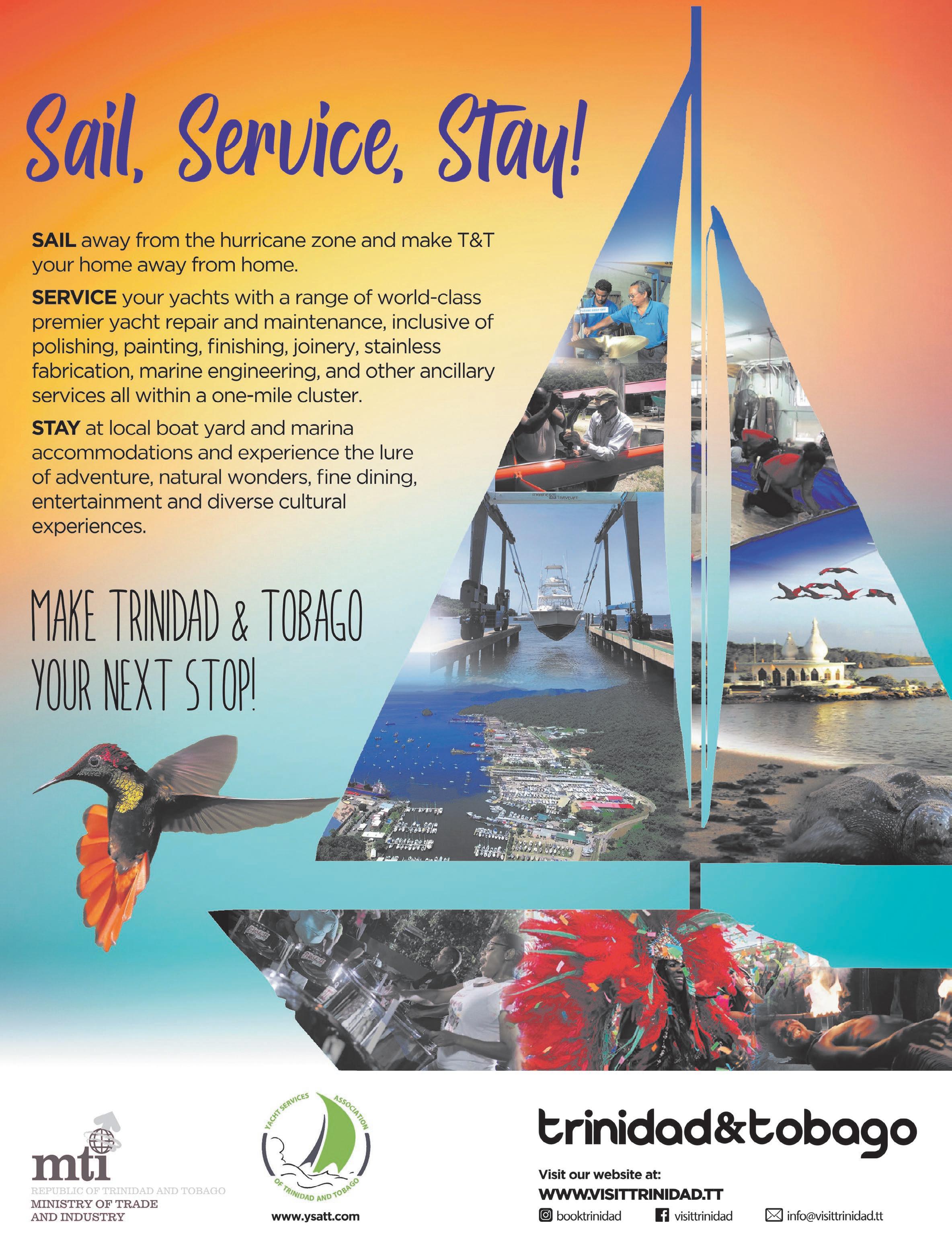
AUGUST / SEPTEMBER 20 23 CARIBBEAN COMPASS PAGE 15
CARIBBEAN ECO -NEWS
Escazú Agreement finds strong advocates in Jamaica and Belize Jamaica and Belize, two Caribbean countries known for their stunning natural beauty and biodiversity, have recently signed the Escazú Agreement, named after the Costa Rican town of Escazú, which was adopted in 2018 by the United Nations Economic Commission for Latin America and the Caribbean (ECLAC). The agreement aims to promote environmental protection, ensure access to information, and foster public participation in environmental decision-making.
The signing of the Escazú Agreement by Jamaica and Belize is a significant step toward promoting sustainable development and protecting the environment in the Caribbean. Both countries have rich natural resources and a diverse range of ecosystems, including coral reefs, forests, and wetlands. However, these resources are increasingly under threat from climate change, pollution, and unsustainable development practices.
However, the Belize Network of Non-Governmental Organizations (BNN) has released a statement in response to Foreign Minister Eamon Courtenay's comment that Belize would postpone ratification following Cuba's decision not to ratify the agreement.
In the letter, BNN called for the government to ratify the document as an opportunity to become a regional leader on environmental issues. That open letter was soon followed by the agreement's ratification by the government of Belize. The ratification of Escazú by Belize is significant, as it could potentially make the country a regional leader on environmental issues.
Organisers like YaYa Marin Coleman of the UBAD Educational Foundation (UEF) have taken it upon themselves to educate their communities about the agreement and its potential benefits. Their campaign took the form of targeted Facebook posts tracking UEF's communications with the Department of the Environment about the project. It also included regular Zoom 'community hangouts' where experts from Belize and the Caribbean spoke to Marin Coleman and other UEF representatives about the port's potential harm in addition to the interventions that the agreement could make possible with its ratification.
— This story was published with the support of the Caribbean Climate Justice Journalism Fellowship, which is a joint venture of Climate Tracker and Open Society Foundations.
Condensed from an article by Rochelle Clayton in the Jamaica Observer (jamaicaobserver.com/news/escazu-agreement-finds-strong-advocates-injamaica-and-belize).
Curaçao “Underwater Space Station”
The National Oceanic and Atmospheric Administration (NOAA) and Proteus Ocean Group have signed a formal agreement to build the first “underwater space station of the ocean,” called PROTEUS, off Curaçao. The underwater lab will give scientists extended time on the ocean floor to study marine life and the effects of climate change.
"This partnership has the potential to greatly expand our capabilities in studying the ocean," Jeremy Weirich, director of NOAA Ocean Exploration, said in a statement. "By living underwater for extended periods in this new ocean laboratory, we'll be able to unlock the ocean's mysteries so that we can better manage, sustainably use, protect and appreciate its resources."
Senator Kamina Johnson Smith, Jamaica minister of foreign affairs and foreign trade, emphasized the importance of the agreement for Jamaica and the wider Caribbean. "We are thrilled to sign the Escazú Agreement and join other countries in promoting environmental protection and sustainability,” she said. “Jamaica is a small island developing state that is particularly vulnerable to the impacts of climate change. By signing this agreement, we are taking a proactive step towards protecting our natural resources and building a more resilient future for our people.”
Similarly, Orlando Habet, Belize minister of sustainable development, climate change and disaster risk management, highlighted the benefits of the agreement for Belize's rich natural heritage. "I am happy that I could have taken that document to Cabinet,” he said. “Cabinet gave its full support showing that our government is certainly willing and truthfully engaging the public because it provides information, accessibility and justice.”
Jamaica is among the first six countries to sign the agreement, but it has yet to ratify the treaty. The treaty also includes specific provisions on protecting environmental defenders, who are often at risk of violence, harassment, and intimidation for their work. Jamaican journalists have argued that ratification would greatly benefit their work covering stories on the local environment and urge their government to take the issue seriously.
In Belize, the significance of the Escazú Agreement might be unclear to those not within direct environmental networks. Since Belize signed the agreement in 2022, there haven't been distinct awareness campaigns made by government ministries or national conservation non-governmental organisations.
"On PROTEUS we will have unbridled access to the ocean 24/7, making possible long-term studies with continuous human observation and experimentation," said Fabien Cousteau, grandson of Jacques Cousteau, founder and chief ocean explorer of Proteus Ocean Group.
PROTEUS will include the use of hydroponics, which will allow inhabitants inside the underwater lab to grow fresh plants for food. The habitat will be powered by wind and solar. It will also include a full-scale video production facility to provide continuous live streaming for educational purposes.

PROTEUS is still in development, and there is no timeline yet for construction.
Condensed from an article by Sheri Walsh in Science News (upi.com/Science_ News/2023/05/04/noaa-proteus-underwater-ocean-habitat/2731683173160/)
—Continued on next page

AUGUST / SEPTEMBER 20 23 CARIBBEAN COMPASS PAGE 16
ECO-NEWS
The Escazú Agreement is a significant step toward promoting sustainable Caribbean development and protecting environments such as the corals of the Great Barrier Reef in Belize.
PROTEUS, the underwater space station
PHOTO CREDIT MMILLSWAN
Continued from previous page
Dominica Workshop Trains Stakeholders in Sustainability

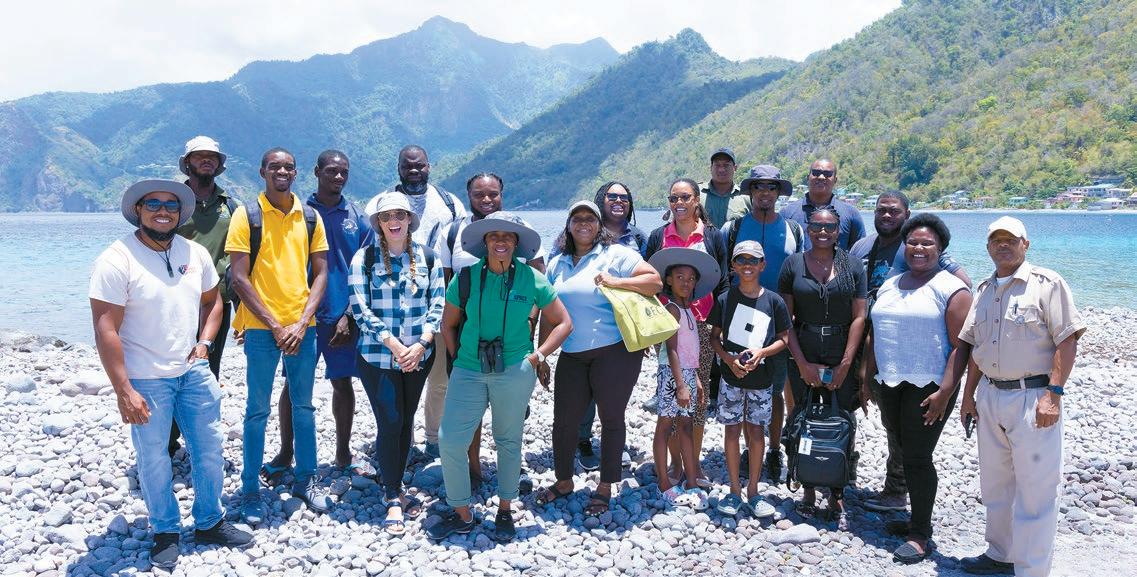
The Organisation of Eastern Caribbean States (OECS) through the EU-funded BioSPACE Project hosted a regional marine biodiversity conservation workshop and sea turtle monitoring training in April in Dominica for regional stakeholders – technical officers, fisheries extension officers, agencies responsible for management of marine protected areas, dive tour guides, and students, among others. Several activities were undertaken to strengthen the capacity of the stakeholders to manage, conserve and sustainably use marine, coastal and terrestrial biodiversity, and to increase their capacity to successfully manage a turtle monitoring program toward the conservation of sea turtle species.
Stony Coral Tissue Loss Disease (SCTLD) is decimating many coral reef ecosystems in the region. Workshop participants discussed the threat in detail and were presented with success stories in dealing with the issue by Simon Walsh of Nature Island Dive, Dominica. Dominican Fisheries personnel have noted the increase in SCTLD and have partnered with dive companies on island to treat the infected coral with antibiotics.
The sea turtle monitoring training examined the life cycle and habits of turtles and identified the species found in the region. Best practice conservation actions were discussed, and participants were equipped with tools to implement these. The facilitators took participants to Rosalie Bay in Dominica, a prime nesting spot for turtles, including the leatherback and hawksbill species. They were taught techniques to monitor and tag the reptiles when nesting.
Fishing Documentary Is Focus of Biodiversity Event
The theme “From Agreement to Action: Build Back Biodiversity” during International Day for Biological Diversity 2023 builds on the strides made at Biodiversity COP 15 hosted in Montreal, Canada, in December 2022, which adopted the Kunming-Montreal Global Biodiversity Framework.
—Continued on next page
Chamberlain Emmanuel, head of the OECS environmental sustainability division, told participants, “Hosting of this training workshop contributes to the implementation of key OECS frameworks and action plans, including the St. George’s Declaration (SGD) of Principles for Environmental Sustainability.” The agenda set out in the SGD 2040 includes climate change and sea-level rise, threats to biodiversity, threats to freshwater resources, land degradation, degradation of coastal environments and marine resources, pollution and waste management, and high energy costs.
Discover the Caribbean's premier private water taxi provider, Dolphin Water Taxi. With a fleet of 12 vessels, we have been proudly serving over 18,000 passengers annually, connecting the United States Virgin Islands and the British Virgin Islands destinations with utmost safety and expertise.

Upon arrival at St. Thomas' Cyril E. King International airport, our experienced customer service representatives eagerly await your arrival at the conveniently located counter in the baggage claim area. As a warm welcome, indulge in your choice of complimentary drinks and rum shots, setting the perfect tone for your welldeserved vacation.
We prioritize your comfort and convenience. Bid farewell to long waiting times as we offer an exclusive no-wait-in-line policy. As soon as you reach our counter, our dedicated VIP concierge service will attend to your every need, escorting you seamlessly from the baggage claim area. Our skilled airport customer representatives will even assist you with completing the necessary customs and immigration forms, ensuring a seamless entry into the BVI.
Shortly after, our VIP cab service will whisk you away to our magnificent harbor, where you will meet your captain and embark on a journey to paradise! Relax in the enclosed cabins, as our skilled crew guarantees a smooth and enjoyable ride to your dream destination. Do not miss the opportunity to visit our popular bar/café located at West End, Tortola, where guests often gather while our captain handles the formalities of customs and immigration.
For over 15 years, Dolphin Water Taxi has been the go-to choice for guests traveling to and from the prestigious Bitter End Yacht Club. Experience the epitome of quick and hassle-free travel with our dockside delivery service, ensuring you reach your destination in no time at all. Additionally, we offer full and half-day private charter boat excursions throughout the BVI, promising unforgettable adventures.
Ready to experience VIP service from St. Thomas to the Bitter End Yacht Club with Dolphin Water Taxi? Contact us today via telephone or email us for more information
We eagerly look forward to welcoming you aboard! Happy sailing!

AUGUST / SEPTEMBER 20 23 CARIBBEAN COMPASS PAGE 17
Biodiversity workshop participants
PHOTO COURTESY BIOSPACE PROJECT PHOTO COURTESY OESC COMMISSION
Marley Andrews, Kingstown Fish Market Vendor, SVG
340-774-2628 · dolphinshuttle@gmail.com FACEBOOK INSTAGRAM TWITTER SQUARE-WHATSAPP
Continued from previous page
In keeping with this year’s theme, the Organisation of Eastern Caribbean States (OECS) created a video documentary, Fishing in St. Vincent and the Grenadines: An Industry Evolved, which examines the development of the industry by the nation’s government, aided by development partners, and its impact on the livelihoods of fisherfolk.
Kris Isaacs, senior fisheries officer in St. Vincent and the Grenadines, said, “We want to have all stakeholders involved and engaged and build their knowledge on the importance of conserving biodiversity, because even though the marine resource can be regenerated, we want to make sure that it is sustainably used, so that the benefits are there not only for this generation but also for future generations to come.”
See the 8½-minute documentary at youtu.be/BiZTWSHJJQI.
IYC Yachts Partners with Common Seas
IYC Yachts, a global yacht sales and charter firm, has announced a partnership with Common Seas, a UK-headquartered non-profit enterprise, to reduce plastic pollution.
Common Seas focuses on influencing plastic policy nationally and internationally, as well as working with businesses and governments on a practical level to reduce plastic use.
IYC is committed to upholding its responsibility as an environmentally conscious company and is taking the necessary steps to increase sustainability in company operations, promote best practices across yachts in its fleet, and raise awareness throughout its network. IYC will also actively participate in Common Seas’ fundraising campaigns.

“The reward of spending time on the water comes hand-in-hand with the responsibility of playing our part in protecting our marine environment. I strongly believe in Common Seas’ mission, and I look forward to working closely together to help further advance their initiatives,” said Raphael Sauleau, IYC CEO.
Cruising Routes Focus of Climate Change Publication
England’s Ocean Cruising Club (OCC) Environmental Team has collaborated with meteorologists and weather routers monitoring traditional cruising routes to produce the publication Climate Change and Ocean Cruising.
It includes a range of viewpoints on the changing patterns that may affect safety at sea and on land. Included are considerations for shortened passagemaking seasons, tolerable temperature ranges, expected changes in atmospheric and ocean currents, storm-free zones, weather extremes and much more.
OCC has also developed a series of white papers and guides to leading practices in seamanship and cruising. These provide practical steps, tried and tested techniques, and practices that have been developed and refined over time with input from subject matter experts and experienced cruisers. The practices now have been incorporated into guides published on the OCC website.
The guides are available as downloadable pdfs at oceancruisingclub.org/ home/news/2356.
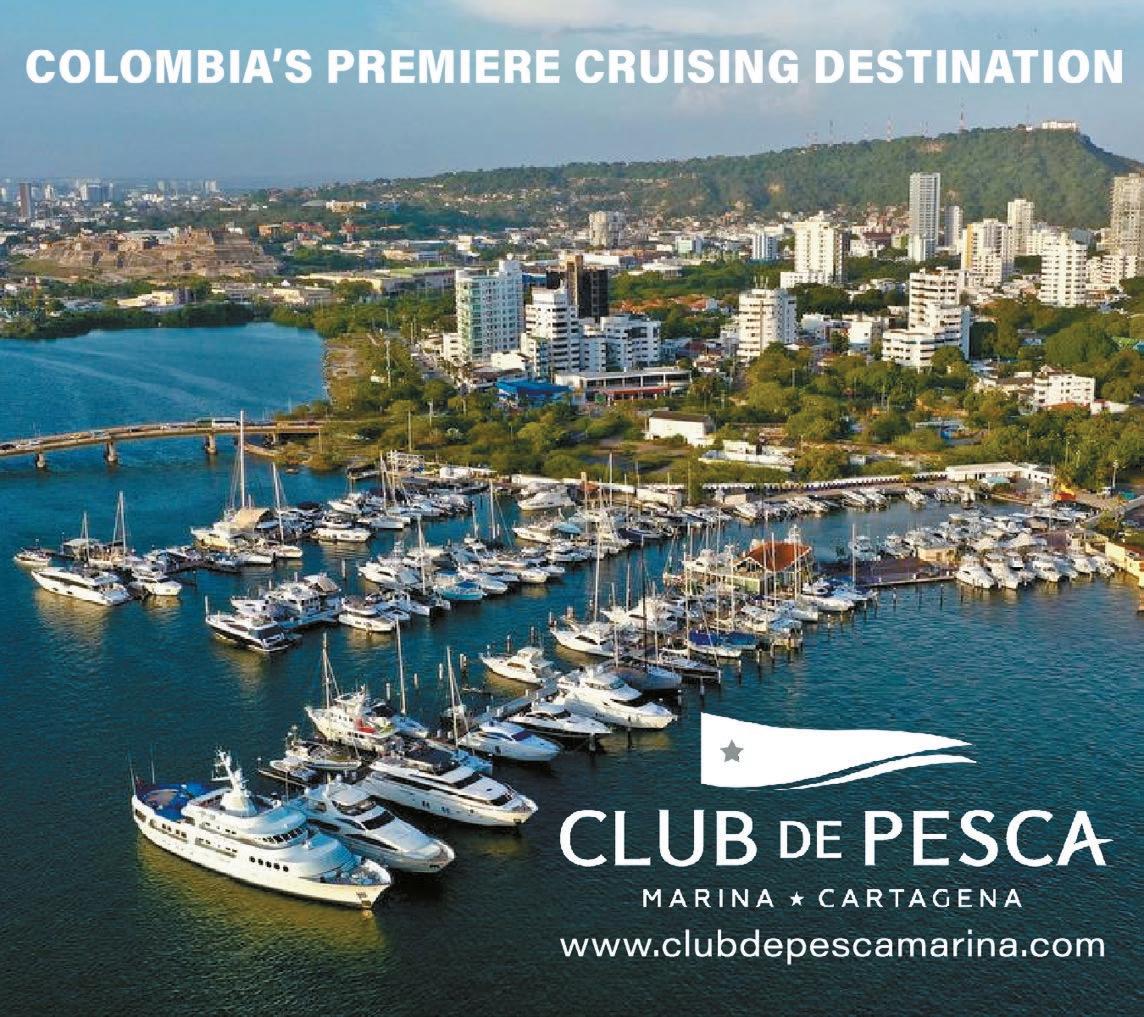
Colombia Training Course Supports Marine Laboratories in Caribbean
Scientists and researchers from marine laboratories in the Caribbean have learned the latest techniques and methods for monitoring microplastics in marine ecosystems at an International Atomic Energy Agency-sponsored training course, hosted by Colombia’s Institute for Marine and Coastal Research (INVEMAR).
Microplastics – tiny plastic particles smaller than 5 millimeters in size – are of particular concern in the ocean, as they can accumulate and cause harm to organisms. The training course, held in Santa Marta, brought together participants from nine Caribbean countries: Antigua and Barbuda, Bahamas, Belize, Dominica, Jamaica, St. Kitts and Nevis, St. Lucia, St. Vincent and the Grenadines, and Trinidad and Tobago. The course focused on using nuclear techniques for the separation, identification and counting of microplastics. Participants practiced field sampling techniques and learned analysis methods for different matrices monitored in coastal environments, such as beach sand, seawater and marine sediments. The skills acquired will enhance marine scientists’ abilities to monitor and report on the presence of microplastics in the ocean.
The participants’ work will contribute to national efforts to meet United Nations Sustainable Development Goal indicator 14.1, which aims to prevent and reduce marine pollution.
Turtle-Friendly Lighting Coming to St. Maarten
Nature Foundation St. Maarten reports: Every nesting season, hundreds of turtle hatchlings on St. Maarten break the surface of their sandy nests and take their first full gulp of salty sea air. Soon they’ll find their way to the waves, guided by the moonlight that reflects on the ocean. Yet many don’t make it to the water because they become disoriented by artificial lights on land.
When they head in the wrong direction, they’re at risk. And even hatchlings that make it to the shore still disoriented from the lights can become dazed and begin swimming in circles, an easy meal for underwater predators.
In cooperation with the Department of Environment of the Government of the Cayman Islands, Nature Foundation has introduced turtle-friendly lighting. Although complete darkness is best, we can compromise on land by replacing fluorescent or white bulbs with red or warm amber ones. Since sea turtles mainly see blue, yellow and green colors, they do not see warmer amber bulbs as well as bright white light.
The concept of turtle-friendly lighting follows three key principles:
1. Keep it low. Mount fixtures as low to the ground as possible to reduce light spillage and use the lowest amount of light (lumens) needed for the area.
2. Keep it long. Use long wavelength light sources (reds, oranges, and true ambers) in the appropriate lighting wavelength of 560 nanometers or above.
3. Keep it shielded. Fully shield the point source of light (i.e. the bulb and/or glowing lens) so that it is not directly visible from the beach.
For more about turtle friendly lighting and its application, please email The Nature Foundation (info@naturefoundationsxm.org).
AUGUST / SEPTEMBER 20 23 CARIBBEAN COMPASS PAGE 18
Using Satellite Data to Navigate
by Joan Conover
Over the past several years, governments have moved away from marine charts in paper to an electronic format. A Caribbean Compass article (2021) described the U.S. National Oceanic and Atmospheric Agency (NOAA) change from paper to an electronic delivery format. Now per NOAA, RNCs (Raster Nautical Charts/vector charts) are planned to be canceled by December 2024. NOAA continues to work on rescheming charts; see project progress online (distribution.charts.noaa.gov/ENC/rescheme). This year, the British Admiralty approved the migration from paper to electronic formats as well.
With the migration to electronic formats, there is also interest in the addition of satellite data to expand electronic chart detail. This is specifically useful for areas with limited or no recent surveys and for locations without the funding to expand or perform new bathymetric studies. This designation limited or old survey data—covers many areas of the world, specifically, in the tropics.

Where the work on Satellite Derived Bathymetric (SDB) becomes of interest to Caribbean Compass readers is on occasions that files are available for the Caribbean, or if sailors are heading to the Pacific Ocean. New efforts to use satellite data to assist in marine chart development for Caribbean waters include downloadable files developed for the Dominican Republic by Bruce Balan of S/V Migration as MB Tiles. Chart Locker, Balan’s website (chartlocker. brucebalan.com), also includes MB Tiles for the San Blas, Turks and Caicos, and Bahamas. Discussion and links to the files are also described (see sidebar). All files and an application (OPENCPN, www.opencpn.org) are open source/free to download and use.
The process for Satellite Derived Bathymetic (SDB) can include automated assigning of a depth derived from values from a recent survey or surveys to individual pixels within a processed set of imagery. (Note: Processing the imagery involves doing some math functions to the Green, Blue, and Infrared wavelengths from an image). These values are impacted by currents, debris and weather impacts on water surfaces. NOAA has recently updated the Nautical Chart Manual (which can be considered the NOAA “rule book” on any number of topics); SDB data received from U.S. government hydrographic processing teams can be used. Prior to this rule change, cartographers had to chart all SDB derived contours and shoreline as approximate. For safety, a caution area, labeled comments, has been added around data based on SDB.
The problem of limited availability of updated marine charts in the Caribbean is exacerbated if governments do not actively survey waters. Currently used are old charts, paper or vector, which have not been officially revised. In some cases, if no government has taken responsibility for
validating the data, they may be many years out of date. Some just show a rough shoreline without detail. It’s up to the captain to navigate with limited information.
Well known offshore mariner John Kretschmer, who recently completed a transatlantic crossing via a far northern route, used electronic charts and paper charts, then compared them with satellite imagery, for course planning. Accurate charts, electronic or paper, for his passages in the far north weren’t available.
Cruisers in the Pacific have also addressed this problem by creating charts from satellite imagery, thanks to bluewater voyaging-sourced inputs. These Pacific charts are available at no charge, as MB Tile formats, usable in some electronic charting applications, such as OPENCPN. They must be used with care; they are not the same as official government released charts used for navigation. SDB-derived charts must be considered a supporting application to compare with existing government or commercial products.
Dave McCampbell (S/V Soggy Paws) has published a detailed article in the SSCA Cruiser Bulletin (March 2023) with discussion of commercial vs. satellite imagery development. He writes: “Several cruisers, including Terry Sargent on S/V Valhalla, Sherry McCampbell on S/V Soggy Paws, Jon Hacking on S/V Ocelot, Balan, and Mike on S/V Zen Again maintain large collections of satellite charts that are shared with other cruisers.
“The image collections number in the thousands, cover from the Eastern Pacific through the Indian Ocean, plus the Atlantic Ocean and the Caribbean, and are continually being enlarged. Tracks in and out of many of these anchorages are also available. These five cruisers also maintain huge collections of anchorages in the same areas with information details included. All this has been made possible by Paul Higgins, who years ago developed a program which includes options for converting a satellite image to a navigation chart. Now there are also multiple sources for other satellite imagery besides just Google Earth images. Cruisers can now choose from multiple images if there are clouds or sun reflections degrading the desired image.”
Hacking’s website includes Pacific and Caribbean files, with great detail on the processing and software downloads (svocelot.com/Cruise_Info/ Equipment/Chart_Downloads.htm).
—Continued on next page
AUGUST / SEPTEMBER 20 23 CARIBBEAN COMPASS PAGE 19 TEST CASES
IMAGE
OF SSCA
MB Tile format, from high resolution Satellite ARC-GIS files of Southern Samaná Bay, Dominican Republic. The area is Miches, directly south of Samaná Town. This image was used to find the location of a stranded yacht that hit a reef in April 2023.
COURTESY
Continued from previous page
Scroll down for both Eastern Caribbean files as well as the Galapagos. As previously stated, these are created from satellite imagery and are to be used with the understanding that they are a support to the captain’s existing navigation tools and charts.
charter boat day moorings.
In sum, MB Tiles do not replace any government marine charts. These satellite images, while useful, are not to be used for navigation. Captains must use validated charts as well as be aware of possible changes; however, satellite images (SDB) do offer a good look for comparison and may help identify possible changes to markers or harbor entries/structures. These sample files are usable on Electronic Navigational Chart applications which can upload MB Tiles such as the free application OPENCPN. If these charts assist cruisers along the northern Caribbean, and the file download/ comments offer encouragement, other areas can be considered on request to the author of this article.

The current marine charts (paper or electronic) for the Dominican Republic require updates to reflect changes to depths, markers and coastlines; most charts are derived from surveys from the late 1960-90s. Coral areas are known for alterations, with sometime rapid changes due to storms. Harbors are modified due to human activity, marine markers and shoals. The “under construction” cruise terminal development and public anchorage/dock changes at Samana, Dominican Republic, is an example.


For the northern Caribbean, current charts exist for the Bahamas, Puerto Rico, and the Virgin Islands. All have been updated recently via government projects. With the Dominican Republic, the most accurate charts are considered by locals to be Navionics with a cruiser-based updating system, as well as Balan’s. Some paper charts are available from commercial vendors based on British Admiralty Charts.
Balan, in discussion with Seven Seas Cruising Association, has suggested creation of satellite imagery charts for more areas of the Caribbean. He proposed images/charts similar to those done in the Pacific.
As an example, SSCA compared the coastline of the northern Dominican Republic to both the satellite and a chart with good correlations. We also made a comparison with data contained in Bruce Van Sant’s book, The Gentleman’s Guide to Passages South . The north coast area, which includes Ocean World Marina, shows a mapped entry, buoys and depths. Images successfully replicate the facility, the bathymetics and the channel markers. This particular area was chosen due to its location to the west of Puerto Plata (which no longer has an anchorage), and the Socha area, now full of

Many thanks to NOAA Office of Coastal Survey, SSCA’s McCampbell, and Balan for assistance with this ongoing issue. The Seven Seas Cruising Association will continue to monitor this topic to improve cruisers knowledge and safety.
Commodore Joan Conover is president and cruising host coordinator of the Seven Seas Cruising Association. She also serves as SSCA’s Clean Wake project coordinator.

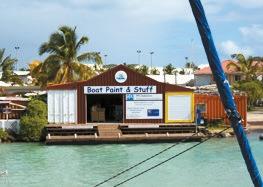
Sidebar
Online Resources and Discussion
nauticalcharts.noaa.gov/updates/studying-the-use-of-satellite-derivedbathymetry-as-a-new-survey-tool
www.hydro-international.com/content/article/reconnaissance-surveyingusing-satellite-derived-bathymetry
www.usgs.gov/special-topics/coastal-national-elevation-database%28coned%29-applications-project/science/satellite#:~:text=Satellite%2Dde rived%20bathymetric%20(SDB),8%20or%20DigitalGlobeWorldView%20 platforms
AUGUST / SEPTEMBER 20 23 CARIBBEAN COMPASS PAGE 20
IMAGE COURTESY OF SSCA
COMPOSITES Time Out Boat Yard Saint Martin Next to the French Bridge Fiberglass + Epoxy & Polyester Resins Epoxy primer + Polyurethane Top Coat Phone: + (590) 690 221 676 info@boatpaintstuff com www.boatpaintstuff.com ANTIFOULING SPECIALIST:
BOAT PAINT &
PPG Amron COPPERCOAT Permanent Antifouling (10 years and more…)
MB Tile format in OpenCPN, satellite image of Marina Puerto Bahia, Samaná, Dominican Republic. MB Tile satellite format vs vector chart detail.
Sample raster chart, the older marine chart format showing Bahamas, as seen in print charts and in electronic plotter format.
IMAGE COURTESY OF SSCA



AUGUST / SEPTEMBER 20 23 CARIBBEAN COMPASS PAGE 21 Save the Ocean, Protect Your Passion “Join us today, we need all hands on deck if we are to have a living, thriving ocean for future generations to enjoy.” Sailors and boaters, you witness firsthand the devastating threats that our oceans face such as plastic pollution, oil spills, and marine habitat destruction. Join Sailors for the Sea Powered by Oceana’s community of Green Boaters to take action to protect our waters. sailorsforthesea.org/Liz Scan to receive our Green Boating Guide
Liz Clark, sailor, surfer,
-
and environmentalist
FIFTY YEARS IN 2023
The Bitter End Yacht Club Is Back!
By Michelle Slade
We approached the Bitter End Yacht Club by water and the scene that opened up before us hummed with early morning activity — boats tying up at the docks, the open-air reception area a dynamic pass-through for guests coming and going, and playful kids leaping off a floating pontoon into the warm turquoise water just off the beach. Those first impressions captured the essence of something that was different to what had been before, yet in many ways, was just the same as it always had been.


The world-renowned and beloved resort, which has been in existence in some iteration since the ‘60s, is open again for business after a devastating loss in the wake of Hurricane Irma in September 2017. The resort lost some one hundred structures; just one original cottage was spared. When disaster strikes, there is nothing more to do than to gather the pieces and start the next chapter, which is precisely what the folks at the Bitter End Yacht Club have been doing these past six years. Rebuilding the resort in the British Virgin Islands’ North Sound has been as much of a spiritual endeavor as a physical task of reconstruction; it needed to be purposeful, as Kerri Jaffe, President, BEYC International, noted.
“We had to find ways to reinvent that so it existed in every element of what we did.”
Over 50 years, based on the needs of the clientele and the owner’s vision, the original BEYC had become a rambling nautical village, and the tactical design goal was to preserve that feeling. Recreating the original BEYC perfectly would have been inauthentic, so while inspiration has been lifted from the past, it is noticeable that each structure has a different look and feel through the use of contrasting wood species, color, and mixed materials — old and new — which have succeeded in recapturing that quintessential village feeling and the resort’s salty past.
“We looked to our history because it was so important to us that people felt that legacy and sense of place when they arrived at the new BEYC,” she said.

The new build is hurricane-proof to modern standards and flood-friendly, and the overall layout is compact, which draws people together around cocktails and a multi-dimensional dining experience: grab coffee and pastries (all handcrafted onsite) to go at the Bitter End Barista or enjoy casual dining inside at The Buoy Room. The Reef Sampler brings together boats, beaches, and bars ... right on the beach. A boat-turned-bar constructed from a salvaged hull raised from the North Sound following Irma, The Reef Sampler is just one of many recycled details incorporated into the reconstruction.
—Continued on next page
AUGUST / SEPTEMBER 20 23 CARIBBEAN COMPASS PAGE 22
CELEBRATING
The central Bitter End village along Marina Beach features a mix of new materials and those salvaged from the destruction inflicted by Hurricane Irma in September 2017.
PHOTO COURTESY OF BEYC
Bitter End’s state-of-the-art Quarterdeck Marina at sunset. The dive flag for partner operator Sunchaser Scuba is visible beyond the marina.
Kamiah is not only a member of the marina team, but also the Bitter End chalkboard artist.
PHOTO COURTESY OF BEYC
PHOTO COURTESY OF BEYC
Continued from previous page




Likewise, décor in The Clubhouse Restaurant, which offers open-air dining and incredible views of the North Sound, has been recovered from hurricane debris adding to its rustic-with-a-touch-of-nautical elegance in keeping with its origins; The Clubhouse was possibly the earliest bar in the North Sound, built by Bitter End’s first proprietor as a spot for yachties to stop by for cocktails and a meal.
“Everything hanging on the gallery wall in The Clubhouse survived the storm,” Jaffe said. “As a steward of the seas and the community that surrounds the resort through the Bitter End Foundation, it was mission critical to the owners that we kept the environmental footprint as small as possible. We really foraged, we upcycled and recycled every scrap of material we could including timber, large scale beams, we crushed all of the concrete for reuse. Among the debris we found pieces of BEYC history — room signage, directional signage, photography, portholes, which was so special and we knew these elements would connect the old with the new.”
Presently, the resort has just two stunning Marina Lofts the first overthe-water bungalows in the BVI available for overnight stays on the island. The rebuild plan intended to first establish dining and recreation amenities to host the boating community, many of whom stay aboard private vessels. The long-term plan, says Jaffe, is a 22-room boutique hotel, six Marina Lofts, hillside cottages, duplex cottages for large groups, and, for the first time, six beach “shacks,” which will be located to the north of the watersports center Boating guests are enjoying the new marina with its wider slips and dockage layout customized to accommodate boats of all sizes and shapes, including multihulls, and the anchorage option via any one of 72 mooring balls. The BVI has long been recognized as the watersport playground of the Caribbean and nowhere better than from the Bitter End is it possible to sail, kiteboard, wingfoil, windsurf, SUP, or fish. The BEYC’s watersports center offers rental gear, and instructors are at hand. Bonus: boaters are welcome to use the club showers; charge is $3 for those who aren’t club guests. Anyone taking a lesson at the watersports center is welcome to shower for free.



Many of the staff at BEYC have been part of the fabric of BEYC history for years through their parents and their grandparents, notes marketing manager Ellinor Walters Donlan, who resides part time at BEYC. She attributes much of the success of the rejuvenation of the BEYC to its team.
“These are the people that brought the spirit back to the property for us, not how the buildings looked but how the resort felt. We want people to feel that spirit and feel like part of our family because that’s part of the magic that brings people back. We have an absolutely gorgeous location and one of the best places to play on the water in the world but the way BEYC makes people feel is unique.”

AUGUST / SEPTEMBER 20 23 CARIBBEAN COMPASS PAGE 23 HEY, READERS! Visit our website at caribbeancompass. com or just scan the QR code BELOW and enter your email address — it’s as easy as that!
Left: Waterfront manager Nick Putman heads out for a sail with some guests aboard one of the Hobie Waves in the Club fleet.
Right: The table is set at the Clubhouse, just in time for a sunset dinner, with a view of the anchorage off Marina Beach.
PHOTOS COURTESY OF BEYC
Some watersports pleasures are timeless, no matter how much surroundings might change.
PHOTO COURTESY OF BEYC
Falmouth Freddy and the Cruising Kanes
By Niamh McAnally
Chapter 2: BVIs Virgin Gorda/Anegada Passage
In northern Virgin Gorda, at Leverock’s Happy Arrr! , tourists and boaters gulped their rum punches. The pirate, aka Michael Bean, was in the middle of his shtick, amusing some with his attempts to cram as many arrrs into his two- arrr show and eliciting groans from others. On the edge of the crowd, Logan Kane sipped his Painkiller—the cocktail that was supposed to get you from zero to naked in 3.2 glasses. The only item Logan wished to discard was the parrot hidden in his bag. It had landed on their rigging in Jost Van Dyke on New Year’s Eve. Had its owner not deliberately left without it, a chartered catamaran would never have squeezed into the space, then dragged into them causing the death of his laptop and a three-week diversion to pick up a new one in Puerto Rico. Yet the accident also meant that Logan had unintentionally held a longer position in an IPO than his normal day-trade protocols dictated, and now they had enough wealth to finance the next three years cruising the Caribbean islands.
for tourists to take selfies with a real live Pirate of the Caribbean complete with talking parrot.

The distraction gave Logan and Charlotte the opportunity to slip away unnoticed.
Back onboard S/V Market Play , sans le perroquet, Logan plotted tomorrow’s route to Saint Martin while Charlotte prepped easy food for the trip across the Anegada passage. They had planned on being there a week ago and were now in a time crunch to meet Charlotte’s brother and sister-in-law flying in from France. It would be their first overnight voyage but Logan had been sailing since his teenage summers on Lake Michigan and they’d regularly sailed with friends on vacation before buying their cutter-rigged sloop. The Caliber 40 drew 5½ feet, so rather than attempt the potentially skinny water by Saba Rock Resort, he routed them the long way around between Moskito and Prickly Pear.
The following day they set off at 1400, planning to arrive at Marigot Bay just after sunrise, which would hopefully give them enough time to clear customs and get to the airport on the Dutch side before the plane landed. Logan took the helm, Charlotte tucked up against the bulkhead facing aft, a copy of Doyle’s cruising guide for the Leewards on her lap. The weather was favorable, winds 14–16 knots from the northeast, seas 2-4 feet.
They were just passing south of Necker Island when they heard the squawk of a parrot.
Logan looked off to port. Surely it was just the call of the birds on Richard Branson’s island being carried across the water. But they heard it again, only louder.
“What the bleep,” Logan said, looking around the cockpit and up through the window in the bimini.
“ What the f**k ,” chirped Freddy from somewhere unseen.
Charlotte pointed to the dinghy suspended on the davits behind Logan. “It’s coming from there.” She maneuvered around the steering wheel and pulled back the cover on the dink. Freddy sat in a small plastic box next to a scrawled note which read:
‘You arrr welcome, matey.’
Charlotte groaned. “Damn Pirate.”
“Damn pirate, damn pirate.”
For once she agreed with the bird. “Now what?” she asked Logan. But the parrot answered first.
“Freddy Fly Home, Freddy Fly Home.”
“What are we now, in a re-make of ET?” Logan sighed. “Where’s home?” he asked, trying to ignore the fact that he was actually talking to a parrot.
“Falmouth Freddy, Falmouth Freddy.”
Still, the parrot was annoying. For the past month Falmouth Freddy had done nothing but squawk, poop on deck, and repeat every curse he and Charlotte uttered. Who knew parrots could be multi-lingual. Like Logan, Freddy had become a real Francophile.
As the sun began to set, the pirate left the wooden stage on the water’s edge and worked his way through the crowd passing around a conch shell. The noises these drunken sailors emitted through the tiny hole in the pink shell ranged from anything you might hear from a four-year-old learning the violin to cow farts. Clearly the island cocktails affected one’s ability to pucker.
“Arrrnyone else?” asked the pirate.
Logan raised his hand. Charlotte looked at him and shrugged in that Parisian way of hers.
“This will work, Char, I promise.”
Logan opened the backpack on the ground beside him, stood up, and blew. A long, melodious, deafening sound that had the crowd clapping and cheering. The parrot flapped out of the bag and landed on the pirate’s shoulder.
“Arrr matey! What’s your name?
“ Falmouth Freddy ” the bird sang.
“F o w l-mouth did ya say?
“More like Foul-mouth,” said Logan.
“ Merde! Bordel de Merde! ” said the parrot, proving his point.
The crowd cackled, thinking this was part of the act. Michael Bean then pranced through the outdoor restaurant, stopping long enough at each table
“Wait,” said Charlotte. I just read about Falmouth. She flicked through the guide. “Here it is, it’s next to English Harbour in Antigua.”
“Antigua! We’re not keeping Freddy until then.”
“Keeping Freddy, Keeping Freddy.”
As the night grew blacker the winds swung more south-easterly and increased to 26 knots, gusting 34. The seas built on top of the swell. It was likely to get worse. Logan had hoped he could have had all his easterly passages done ahead of the Christmas winds. He considered turning back but they were under pressure to get there. Yet, deadlines, he knew, were the enemy of sailors. The bow dug into the waves, the red and green navigation lights illuminating the water one moment, the sky the next. Then came the squall.
Freddy, apparently not enjoying being sloshed about in the dinghy, hopped onto the rail and perched himself on the stern seat as though he was another member of the crew keeping watch.
Logan disengaged the auto-pilot and took control of the wheel. “This is why they call the Anegada passage the—"
“Oh-my-God-a! Oh-my-God-a!” screeched Freddie. “We’re going to die!”
If you missed Chapter One of Falmouth Freddy and the Cruising Kanes, you can catch up in our June-July issue (caribbeancompass.com/online/327-JuneJuly-2023.pdf).
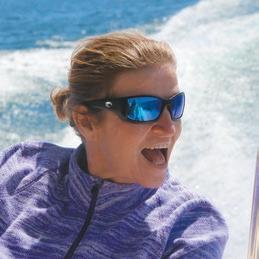
AUGUST / SEPTEMBER 20 23 CARIBBEAN COMPASS PAGE 24
Niamh McAnally is an Irish-born former TV director turned author (see page 8). She hosts interactive “behind the scenes” presentations to various groups and book clubs. To learn more visit www.thewriteronthewater.com.
The parrot flapped out of the bag and landed on the pirate’s shoulder.
DIGITAL PAINTING BY TAD RICHARDS
COST CONTROL WHILE YOU CRUISE
Adapted from Lin Pardey’s Cost Conscious Cruiser
New Year’s, a time when our wide-flung fleet of cruising friends – even those who hate writing – send us emails and yes, some even send letters letting us know where they are, and how they have fared. Because the majority of these newsletters and notes come from people who have broken free to explore under sail, we gain considerable insight into how cruising styles, cruising locations, and personal choices affect cruising costs. And year after year, the same patterns seem to emerge. Although boat size will always affect cruising costs, comparing the experiences of two of our most budget-minded friends over the past year highlights other major factors that keep some people cruising within their financial means while others “break the bank.”
The crew on one 40-year-old, 35-foot (10.7m) sloop, both in their early 30’s, stuck to their $1,000-a-month budget, even though they were exploring in Norway, possibly the most expensive country in the world. The other couple, on a brand-new, classic-design 28-footer (6.7m) built of GRP, were cruising in Mexico, a country known for its relatively low cost of living. This couple is returning home a year earlier than planned, having overrun their $1,200-a-month budget by almost double. What are the major differences? The crew on the first boat, along with most of our friends who stay on target year-in, year out:

1. made their boat unstoppable;
2. kept sailing in light breezes;
3. were willing to postpone repairs of nonessential gear until a more appropriate time;
4. were comfortable being at anchor instead of in marinas;
5. did not enter races/rallies and limited the time they spent sailing in company;
6. slowed down and spent a lot of their time with local people.
As we discuss in detail these and some of the other less obvious ways you can cut your cash expenditures, you will notice that many offer other benefits. These range from saving time during the ideal sailing season to adding emotional pleasure to your cruise.

Make your boat unstoppable Achieving this requires that you accept that your boat is first and foremost a sailing machine, the engine an auxiliary and convenience. If you outfit it from this premise, then practice sailing to gain confidence in your skills before you set off, you will be en route to unstoppability.
The next step is to make sure that all of the essentials – from sailhandling to steering to food storage and preparation to navigation – can be done with gear that can be repaired by you and/or is not dependent on the engine or the boat’s electrical system. In many instances, this can be achieved by carrying self-contained backup gear powered by solar cells, or dry-cell batteries. A back-up handheld GPS, a sextant, printed charts, separate solar powered cabin and navigation lights, hand pumps for water systems, a backup single-burner camping stove – all these mean you can sail onward even if the electrical system or the engine fails or you run out of fuel.
—Continued on next page
AUGUST / SEPTEMBER 20 23 CARIBBEAN COMPASS PAGE 25
Sahula is the 12 meter Van de Stadt I voyage aboard with David Haigh. Adding light air sails to her wardrobe has cut down on her fuel expenses.
PHOTO BY LIN PARDEY
Continued from previous page
When we were at anchor at St. Helena Island, one of the most isolated communities in the world, the owner and crew on a 40-foot (12.2m) ketch arrived, their crew frightened and disillusioned because their engine had seized and nothing on board worked – no lights, refrigeration, navigation gear, or anchor winch, nor water pumps. They had no way to get fresh water out of their bilge tanks (the tanks had no visible inspection plates large enough to scoop out some water). The next scheduled supply ship wasn’t due for ten weeks. At that time there was no airport on the island (an airport was finally built in 2016 but didn’t have scheduled flights for a few years after that).
By limiting the complexity of electronic instrumentation, using a Hydrovane windvane self-steering system and simple Pelagic autohelm, we keep our costs in control. But there are times, such as when the tradewinds blow fresh, when being on the helm is sure joy.
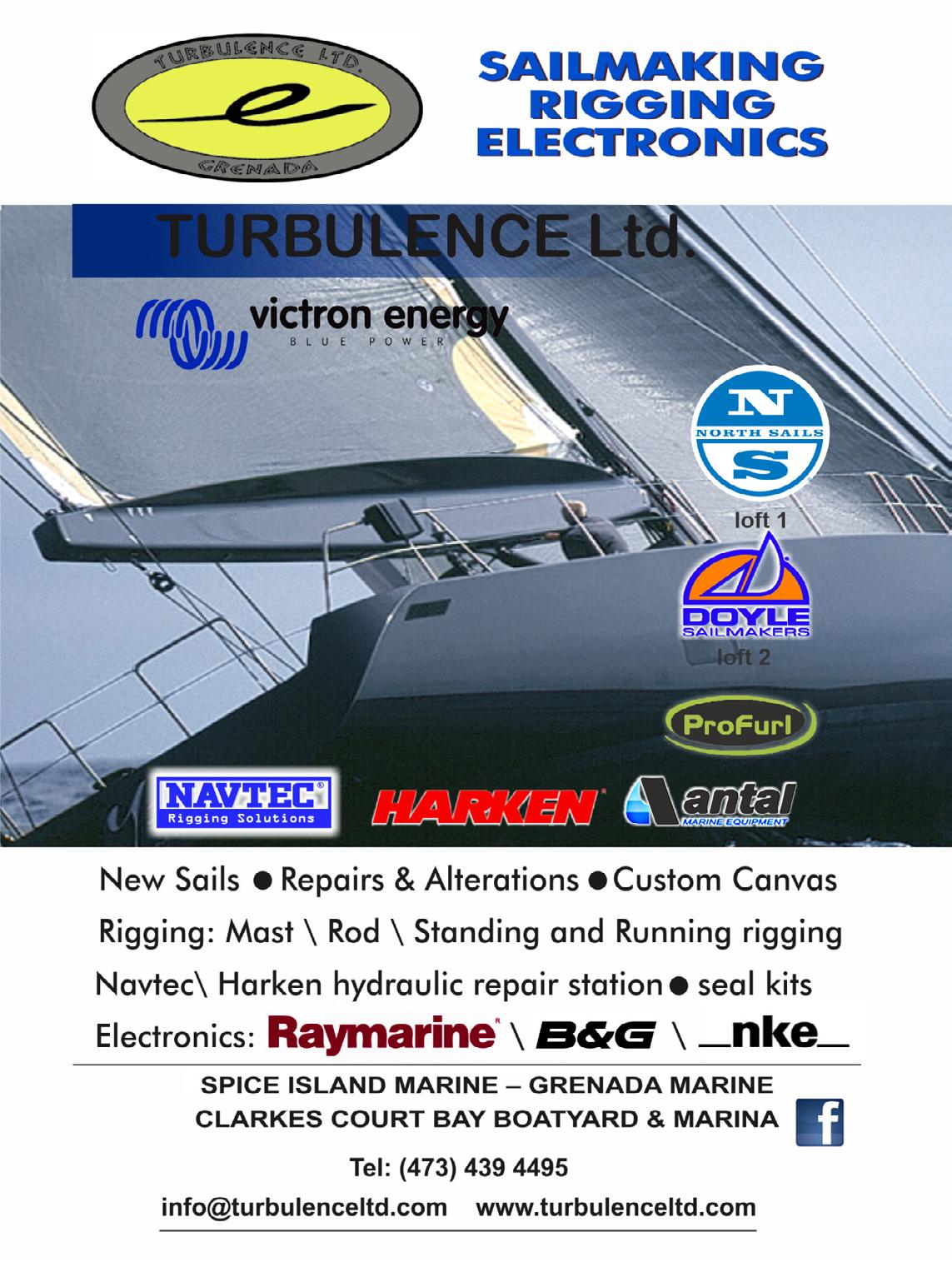
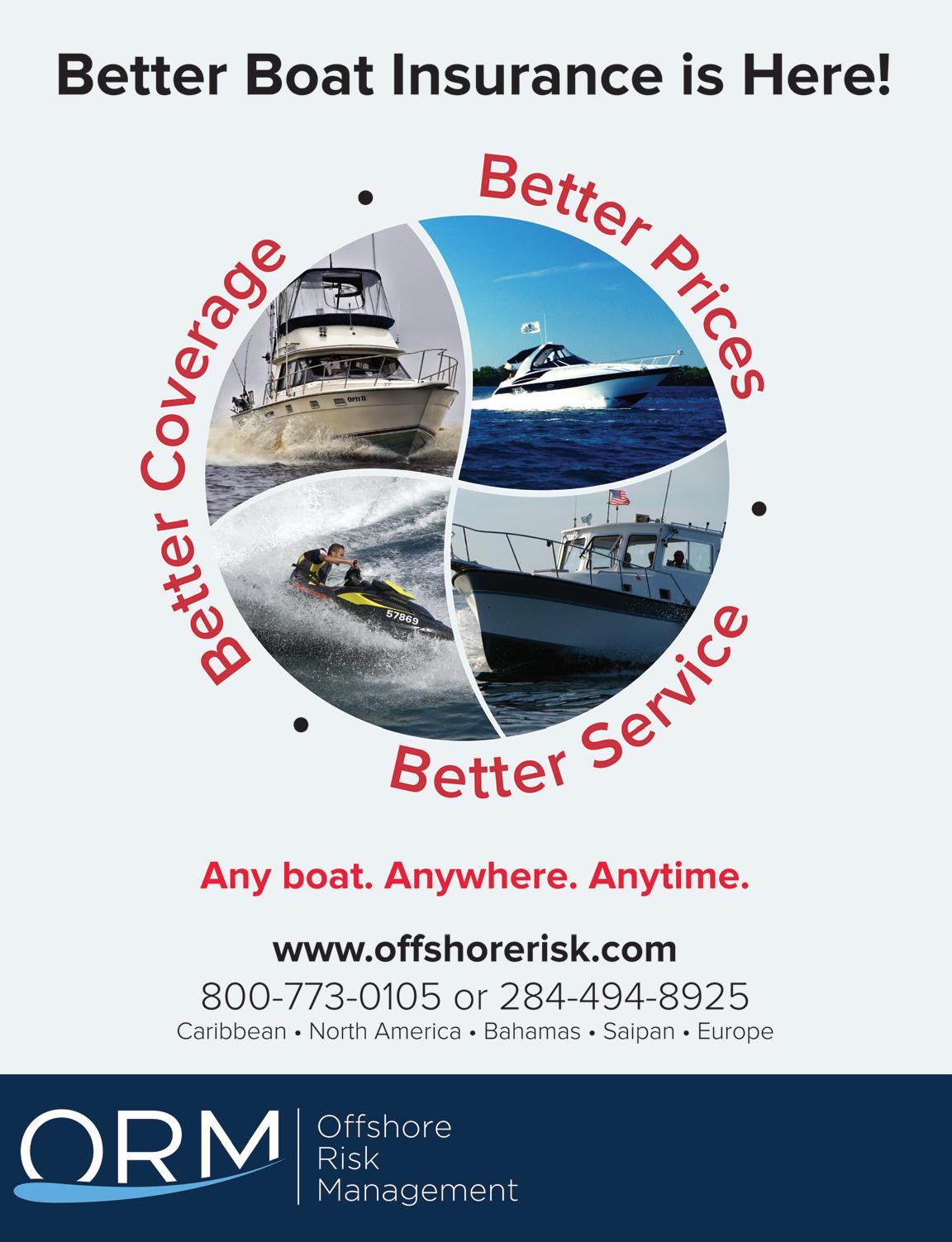
The owner contacted the Royal Cape Yacht Club and arranged for another yacht to bring parts and a yacht delivery team. Six weeks of lying in the swell-tossed roadstead gave him time to realize that he wasn’t comfortable having his life controlled by machinery. So, he reconsidered his dream. When parts arrived and repairs were finished, he and his crew returned to South Africa, where the boat was sold. An extreme case? No. We've seen variations on this story all over the world. The cost of trying to get any but the simplest of gear fixed “right now” in Tonga could be twice the cost of waiting until you sail to New Zealand, where parts and repairs are not only available but also dependable. Even with non-interdependent gear, some people cannot bear the idea of knowing that something on board isn’t working correctly. They want it fixed “right now.” We were in Bora Bora, French Polynesia, when a sailor I’ll call Bill decided he was going to solve the problem of batteries that didn’t seem to stay topped up. The boat was a fine sailing machine and Bill and his wife were both good sailors. In fact, we were all at dinner together when his wife suggested they live with the problem and sail on to American Samoa, where they knew good repair people were available and it would be relatively inexpensive to buy new batteries if required. But Bill persisted. The repair turned into a three-week saga of living with a disassembled boat and a frustrated family. Over cocktails one evening, his wife said, “It’s not the money that hurts, it’s that we are here in the middle of paradise spending day after day being too upset to enjoy it all.” Bill finally had to fly to Papeete and carry back new batteries. When he installed the batteries, he was heartbroken to find the whole problem had been the fault of a bad connection between the ground strap and the engine block.

On the other hand, consider Laura and Randy Hacker-Durbin. They had been cruising the Pacific for two years on their self-built 40-foot (12.2m) cat-ketch Pollen Path. Laura sent us a letter outlining their concerns when the approaching cyclone season made it important that they set sail from Lautoka, Fiji, to the safe haven of New Zealand, even though their engine had packed up. After ten days of sometimes sailing, they reached the entrance to New Zealand’s Bay of Islands, where a new adventure began. The breeze died down to a whisper and as Laura wrote, “Andy began digging the dinghy and outboard out of the forepeak to lash it alongside and motor us in. But for me it became a challenge to see if we could sail the whole way from Fiji. We began ghosting up the channel on the incoming tide. The satisfaction was immense when we dropped the anchor. The passage became a real accomplishment for both of us – we had sailed the whole way.” They definitely illustrate the advantage of creating an unstoppable boat.
This is the first of a four-part Caribbean Compass series by Lin Pardey, adapting and updating material from her 1998 book, Cost Conscious Cruiser, available from Amazon (amzn.to/3o7CuGn), or ask for it at your local bookstore. She’ll continue with tips two through six in coming issues. And check out her blog at pardeytime.blogspot.com.
AUGUST / SEPTEMBER 20 23 CARIBBEAN COMPASS PAGE 26
PHOTO BY DAVID HAIGH
Saint Lucia Style
Discover a summer like no other, on an island like no other. Saint Lucia radiates a warmth that lasts long after the sun goes down. It’s an island where rainforests are lush, beaches are serene, and natural beauty must be seen to be believed. Here you can fill your days with all kinds of memorable activities, including chocolate-making classes, rum tasting, and catamaran cruises. For inspiration visit stlucia.org
stlucia.org

AUGUST / SEPTEMBER 20 23 CARIBBEAN COMPASS PAGE 27 DISCOVER SUMMER
Game-Changing Galley Gadgets
By Joyce Gauthier
The galley is arguably the most important space on a cruising boat. Good food keeps morale high and supplies energy for hard-working sailors. Creating a healthy, environmentally-conscious, and energy-saving galley can easily be achieved with a few carefully selected gadgets.
Portable Blenders
Long gone are the days where the NutriBullet was the only game in town. An online search results in endless options for blenders. Technology has provided us with small, portable, USBcharged blenders. The portable we use on our boat is the BlendJet 2, available at Target, Walmart, Kohl’s and Amazon for $49.99. The BlendJet 2 won’t drain your battery bank with one frozen margarita. Its versatility provides our crew with smoothies, shakes, sauces, and dressings — and we aren’t tied down by a cord, either. Happy hour on the beach just got more exciting.
Pros:
• You get about ten blending cycles before needing to charge it, so you don’t have to have it plugged in while in use.
• Easy to clean. Put water in the blender and blend.
• Charges via USB.
• Small size for easy storage.
Cons:
• Not as powerful as other small blenders like the NutriBullet.
• Small size means less capacity.
Who needs this:
If your boat doesn’t have enough power to run a NutriBullet or Magic Bullet, this is a great compromise. If you are looking for a simple way to make smoothies, protein shakes, and homemade dressings, this is the product for you.

Compost Bins
Isn’t it annoying when a broccoli stalk washes up on the beach because someone tossed it overboard in the anchorage? Avoid being “that boater” by storing your food scraps until you are offshore or in a destination where there is trash. There are three options for storing food scraps on a boat. First, the most frugal option, is a recycled container on the galley counter (like the yogurt container we used for years). The container can store your food scraps until you can properly discard them. But after a few days, the smell of old food scraps can creep into your galley when using a container that was not designed to hold compost (after a while, we were afraid our yogurt container was powerful enough to start walking around on its own).
To avoid the smell, consider a compost bin. Amazon has an extensive selection within the $20 to $60 range. The plastic ones are least expensive and the bamboo or stainless steel models will run higher in price. Countertop compost bins have a seal that keeps smells inside the bin and out of the galley. They are also more aesthetically pleasing than an old yogurt container.
The third option is an electric composter. The advantage of the electric model is its efficiency in turning food scraps into soil. Untreated compost in a bin will turn scraps into soil that can be used for composting your kitchen garden, but it can take two weeks or longer. Lomi.com has a tabletop electric compost bin that turns food scraps into soil in under four hours. According to Lomi.com, the “Lomi uses between 0.6 to 1.0 kWh per cycle,” as much power as a dishwasher.
Pros:
• Makes your garbage less smelly.
• Keeps organic materials from making their way to landfills.
Cons:
• Takes up counter space.
• The electric version uses a fair amount of power.
• The electric version is priced at $349.
Who needs this:
Boaters who are environmentally conscious. Composters are also a responsible way to manage trash on a boat. If you sail in remote places, this is the gadget for you.
SodaStream

According to Forbes magazine, the SodaStream has been around since 1903. For decades it was a “toy for the upper class.” In the present day, it can be found at Amazon, Target, and Walmart starting at $99.99. The SodaStream is a device that adds carbonation to water. It takes up a lot less space than provisioning canned and/or bottled seltzers and sodas. One of the required CO2 cartridges can make about 60 liters of sparkling water. A variety of flavorings can be added to the carbonated water as well. I personally like to put fresh lemons and limes into my seltzer. The SodaStream is a fun way to create a diverse offering of drinks available onboard.

Pros:
• Saves space.
• Environmentally friendly by decreasing the amount of bottled and canned beverages onboard.
• They are sturdy. Our SodaStream went flying across our boat during a sporty sail. The SodaStream was unscathed; our teak and holly floor was not so lucky.
• Less expensive over time than purchasing bottled and canned beverages.
• Makes you look cool and sophisticated, like a 1930s movie.
—Continued on next page
AUGUST / SEPTEMBER 20 23 CARIBBEAN COMPASS PAGE 28
JOYCE’S LIVEABOARD
HACKS
The BlendJet 2 in action, blending a smoothie
The Soda Stream is a spacesaving gadget that is good for the environment, too.
How to look cool and sophisticated using a soda siphon
PHOTO BY JOYCE GAUTHIER
PHOTO BY BEN FOLEY
FOR
OCEANFRONT VILLA & DOCK FACILITIES CULEBRA ISLAND - PUERTO RICO


Numerous attributes characterize the property’s secluded & privileged coastal location, surrounded by Dakity Nature Reserve & boundary to 'Playa Punta Soldado'. Comfortable maritime access to property’s dock with a draft of 6’ in depth. Two-level main villa with multiple adjoining Oceanfront Terraces, hardwood ‘embulla’ & tile floors, half acre+ of land, 6k water cistern, 13 kw power generator, jacuzzi-gazebo, 6 beds & 3 baths, laundry & storage rooms. Established 10 yrs+ short-term Tourism Vacation Rental, rated #1 TripAdvisor-Specialty Lodgings. Additional info/details for the latter available upon request. By Appointments only! Asking price: $2.350M.
For inquiries please contact: artetropical3@gmail.com, pelicangroup@prw.net

Alex Carbonell #787-398-8635
https://www.zillow.com/homedetails/Bo-Culebra-PR-00775/2059843265_zpid/
Continued from previous page
Cons:
• The CO2 refill canisters are about $30 ($15 if you exchange an empty one).
• While it is compact, the SodaStream is tall, which can make storage tricky.
Money saving pro tip:
Keep an eye out at garage sales and thrift stores for SodaStreams. It can save you a boatload.
Who needs this:
Environmentally-conscious boaters who enjoy carbonated drinks. If you are looking for a fun way to increase your water intake without getting bored with still water, this is the gadget for you.
Single-use Gadgets
Good friends of mine, Babs and Tim Carryer, just bought a catamaran. After cruising on their monohull for a season, they made the jump to a Lagoon 380. With the extra space and power from their lithium-ion battery bank, they have a handful of single-use gadgets. A single-use gadget is an appliance that can only make one type of food. They use their rice cooker two to three times a week. Their popcorn maker enhances a happy hour or movie night a couple times a month. While I don’t have the space or power for such luxury, Babs has the space and power for many gadgets, even if they aren’t used often.
Whether you are looking for ways to save on power, create less waste, or shake up your culinary offerings, these gadgets have something to offer for any type of boater. Jump in and start experimenting with galley gadgets to see what works best for your cruising lifestyle.

Capt. Joyce Gauthier is a full-time liveaboard on a 1974 Camper Nicholson ketch, s/v Gavia. It was her desire to see the world that led her to sailing. Since moving onto a boat in 2017 she’s logged more than 20,000 nautical miles. She is a regular contributor to windandwellness.com, a blog about health and wellness for cruisers. Joyce loves creating original dishes in the galley, lounging on white sandy beaches with her husband, Matt, and her shih tzu, Loki.

AUGUST / SEPTEMBER 20 23 CARIBBEAN COMPASS PAGE 29
SALE
Babs has multiple single-use gadgets in her galley.
PHOTO BY BABS CARRYER
The popcorn maker making popcorn for onboard movie watching (perhaps a sophisticated 1930s comedy).
PHOTO BY BABS CARRYER
THE CARIBBEAN SKY: FREE SHOW NIGHTLY!
August to September
Story and Photos by Jim Ulik
“All comets indeed give evidence … of a lot of bad luck, affliction, peril and danger.” German author Thomas Hartmann, 1606.
There are 3,879 known comets as of June 19, 2023. One hundred and eighteen of those are considered to be near-Earth comets because their orbits intersect Earth’s orbit. Twenty new comets have been discovered so far this year. Two historically significant Great Comets have anniversaries this period. The Great Comet (a term attached to any comet that becomes exceptionally bright) of 1882 was first seen on September 1, 1882. The Great Comet of 1807 was observed close to the horizon on September 9 of that year.

Tuesday, August 01
Put spotting shooting stars on hold for a few days. Tonight is the full supermoon. It sits right in the area of sky where all the meteor showers originate. This is the second full supermoon in 2023. The Moon nears its closest approach to Earth appearing slightly larger and brighter than usual.
Saturday, August 05
Mercury reaches its highest altitude in the western sky this evening. The fast-moving planet will seem to stall for a few days, then begin to slip down toward the horizon. Venus dips below the western horizon, disappearing from the evening sky. It will return as a morning apparition on August 26.
The Northern Iota Aquariids begin to radiate out of the east. It will be a few days before its peak, but the shower will add to the overall number of potential meteors this period.
Sunday, August 06
Tonight is the peak of the Southern Iota Aquariids Meteor Shower. This marks Earth’s pass through the first of two debris fields left behind from a comet. The second peak will occur on August 25 when the Earth passes through this comet’s second debris field.
Tuesday, August 08
The Moon is in the third quarter phase. Look for the Moon and Jupiter to make a close approach. They will appear to pass within two degrees of each other. Tomorrow the Moon will move in close to the Seven Sisters.
Saturday, August 12
The Perseid Meteor Shower takes place between July 16 and August 24. The peak shower occurs tonight into tomorrow morning. A maximum of 100 meteors per hour may be seen as the Earth passes through the debris left behind by comet Swift-Tuttle during its 133-year orbit around the Sun. When Swift-Tuttle was very close to Earth in 1993 the peak rate was between 200 and 500 meteors per hour. The source of these meteors will originate near the constellation Perseus in
the northeastern sky around 2300h. These meteors are fast moving at over 135,000 mph (217,000 km/h).
Wednesday, August 16
The Moon is now located on the same side of the Earth as the Sun. The New Moon is the beginning of the Moon phase cycle. This month the Moon will not pass directly between Earth and the Sun. It will be located five degrees north of the Sun. This is the best time to observe celestial objects in the night sky. The Perseid meteor is past its peak, but there are eight more nights to spot shooting stars from this popular shower.
Thursday, August 17
Look for the bright star Vega in the northeastern
sky. Below Vega is the constellation Cygnus. This is the area of sky where the meteor shower Kappa Cygnids originates. This shower is active August 02 – August 25 but reaches its peak tonight. These meteors may leave a lingering tail as they slowly enter the atmosphere.
Friday, August 18
The Moon makes a close approach to Mars low in the western sky. The pair will become visible just after sunset fifteen degrees above the horizon. Mercury can be found just below or west of Mars. If you are out and about around 2000h, look toward the east to watch Saturn rising.
—Continued on next page
AUGUST / SEPTEMBER 20 23 CARIBBEAN COMPASS PAGE 30
A print of a Great Comet: Trouvelot, 1881.
IMAGE
FROM LIBRARY OF CONGRESS
Continued from previous page
Monday, August 21
This evening, the Moon is positioned near Spica, the fifteenth brightest star in the night sky and the brightest in the constellation Virgo. This celestial navigation star is also a cornerstone of the Great Diamond and Spring Triangle asterisms. Looking west toward the horizon around 1900h are the planets Mars and Mercury.
Thursday, August 24

Over the last two days the Moon passed through Libra and entered Scorpius. Tonight it makes a close approach to another navigational star: Antares, the Heart of the Scorpion. Antares is the sixteenth brightest star. This supergiant is located just off the dark side of the First Quarter Moon. As the pair approaches the horizon the edge of the Moon will just touch Antares.
Sunday, August 27
Saturn and the 146 moons orbiting the ringed planet have reached their closest approach to Earth. The planet named after the Roman god of agriculture is shining its brightest this year. From our perspective it is located opposite the Sun throughout the night.
Wednesday, August 30
Saturn remains very bright in the night sky; however, it may be hard to spot this evening. It is located four degrees west of tonight’s Full Moon. Both Saturn and the Moon, situated in Aquarius, will rise just after 1800h. This is the second Full Moon of August, sometimes referred to as a Blue
Moon. The Moon is also near its closest approach to Earth and may look slightly larger and brighter than usual.
Friday, September 01
There may be a few meteors radiating out of the northern sky after midnight. This is the peak of the Aurigids meteor shower, active August 27 –September 06. The Earth is passing through the debris field left behind from a comet that was discovered in 1911. Eighty-six observations were used to determine its orbit. Comet C/1911 N1 takes almost 2,500 years to orbit the Sun.
Forty-one years ago, September 01, 1982, the Air Force established Air Force Space Command, with space operations as its primary mission focused on incoming missile detection, launch operations, satellite control and space surveillance.
Monday, September 04
The Moon and Jupiter will share a spot in the sky overnight. There will be six degrees of separation between them. Jupiter is the bright object off the dark side of the Moon.
Wednesday, September 06
The Moon has left Jupiter behind and joined up with the Seven Sisters tonight. Look for Pleiades above or west of the Moon. Tonight the Moon also reaches third quarter phase in the constellation Taurus.
Saturday, September 09
The epsilon Perseid meteor shower peaks tonight. This is a minor shower, but a few shooting
stars may radiate out of an area north of Jupiter. The best opportunity to view meteors is between 2200h September 09 – 0130h September 10, when the Moon begins to rise.
Saturday, September 16
There is a close approach between Mars and the thinnest of waxing crescent Moons. A clear view of the western horizon at dusk is required to see the pair. Spica is the bright star a few degrees away from the Moon.
Monday, September 18
Venus is at its greatest brightness for 2023–2024 as a morning apparition. Venus will rise in Cancer around 0315 followed by Mercury around 0450.
Friday, September 22
Mercury reaches greatest western elongation of 17.9 degrees from the Sun. This is the best time to view Mercury since it will be at its highest point above the horizon in the morning sky.
Saturday, September 23
The Sun will shine directly on the equator and there will be nearly equal amounts of day and night throughout the world. This is also the first day of fall (autumnal equinox) in the Northern Hemisphere and the first day of spring (vernal equinox) in the Southern Hemisphere. The Sun will rise from the point on the horizon which lies due east, and set beneath the point which lies due west.
—Continued on next page
AUGUST / SEPTEMBER 20 23 CARIBBEAN COMPASS PAGE 31
Continued from previous page
Tuesday, September 26
The Moon is nearing its full phase as it takes up its position near Saturn. The Moon rises just after 1600h. The Sun will set at 1800h when Saturn begins to come into view off the northwest side of the Moon.
Thursday, September 28
During September the constellation Sextans is located about 30 degrees west of the Sun. Venus will rise above the horizon around 0300 at 80 degrees. Sextans will rise one hour later at 90 degrees. The Sextans constellation is the radiant point of the Daytime Sextantid meteor shower. This shower is active September 09 – October 09 producing its peak rate of meteors today. Don’t look toward the Sun to find meteors. The best direction to glimpse any fireballs is 45 degrees away from the Sun.

Friday, September 29
Tonight is the last supermoon of 2023. The Moon is near its closest approach to Earth, so will appear slightly larger and brighter than usual.
IN THE NEWS
Air Force Space Systems Command (renamed Space Force) accepted delivery of the last GPS 3 satellites. The GPS 3 satellites provide military users extra protection from jamming attacks and more advanced broadcast positioning, navigation and timing signals for civilian users. The signals are interoperable with Europe’s Galileo navigation satellites.
*All times are given as Atlantic Standard Time (AST) unless otherwise noted. Jim Ulik sails aboard s/v Merengue

AUGUST / SEPTEMBER 20 23 CARIBBEAN COMPASS PAGE 32
See something streaking across the sky during the day? That may be a meteor from the Daytime Sextantids.
GRAPHIC BY JIM ULIK
Heroes of Herbivory - Fabulous Parrotfishes
Story and Photos by Darelle Snyman
In a previous article I introduced you to some of these fabulous fishes that grace the waters of the greater Caribbean with their beauty, such as the iconic spotlight parrotfish ( Sparisoma viride). Since then I have been lucky enough to encounter more members of the Scaridae clan. As a group, parrotfish need little introduction to divers and snorkelers. Their vivid colors and patterns, and their unmistakable bird-like beaks, make them easy to spot, but a potential nightmare to identify. No wonder the number of species, based on chameleon-like appearance, were once estimated to be over 300, but in reality there are only some 90 parrotfish species swimming around in coral reefs across the world.
Most parrotfish start out life as female, a stage referred to as the initial phase. As they mature, the largest individuals undergo a sex change to become male when circumstances require; this stage is referred to as the terminal phase. The process is accompanied by dramatic changes in coloration, creating male and female individuals so unlike each other that it is easy to imagine them separate species. As often happens in nature, it is the male parrotfish that are endowed with the most vivid colors and intricate patterns, while the poor females seem somewhat drab in comparison.
One such show-stopper is the male queen parrotfish (Scarus vetula), a true beauty cloaked in hues of pale blue-green with distinctive bright blue to green markings around the mouth and eyes. The female, by contrast, dresses in dark gray with a pale head and a distinctive broad white stripe low on each flank. You will typically encounter the attractive male queen parrotfish with a harem of four to five females. Queen parrotfish breed year-round. During courtship, a male will constantly circle a female. If receptive, she will join him in this circling maneuver, resulting in the simultaneous release of their spawn into the surrounding water.

These procreation activities usually occur early morning; for most of the day queen parrotfish, like all their family members, actively scour the reef,
scraping plants and algae from the reef surface with their renowned set of fused front teeth. This constant cleaning keeps macroalgae growth in check, allowing corals to grow and thrive, and reefs to support more fish and other marine life. It is this feeding habit that makes parrotfish irreplaceable within the reef system. Several studies have now shown that the presence of these heroes of herbivory is essential to the overall health of a reef ecosystem.
Parrotfish are not only renowned for their attractive colors and unique beak; many species, such as the queen parrotfish, are known for the mucus sleeping bag they create to sleep in at night. Unusually heavy sleepers, they are capable of ten hours of uninterrupted sleep, a long time to be vulnerable to night-time predators such as moray eels and sharks. They can create this mucus cocoon within an hour and it is believed to mask their scent and act as an early warning system, waking the fish if something brushes past it or tries to nibble at it, such as annoying parasitic isopods.
Another male stunner I swam into, while exploring the beautiful reefs of Belize, was the redband parrotfish (Sparisoma aurofrenatum)—such a gorgeous fish with its distinctive red iris and red stripe under the eye! Its blue-green body clearly shows the large, robust scales parrotfish are known for, and it bears a distinctive yellow and black spot above the pectoral base. Female redband parrotfish have been adorned with more color than some other females; their body color varies from green to a solid olive, rimmed with reddish fins. The juveniles, who do not resemble the adults at all, apart from bearing the red iris and beginnings of the parrotfish beak, prefer to keep to the safety of seagrass beds. Redband parrotfish are, like their kin, primarily herbivores, but are known extend their food repertoire beyond algae and coral polyps to sponges, crabs, brittle stars and sea urchins.
—Continued on next page
AUGUST / SEPTEMBER 20 23 CARIBBEAN COMPASS PAGE 33 GET TO KNOW YOUR CARIBBEAN MARINE LIFE
Redband parrotfish
Continued from previous page
When it comes to chomping down on crusty food, such as coral polyps, to extricate the soft delights hidden inside, parrotfishes have been well endowed with the right equipment. Their teeth are not only composed out of one of the hardest biominerals in the world, fluorapatite, but they also have a set of inner pharyngeal teeth that crush the food to liberate the soft morsels hidden inside. Next time you bump into a group of feeding parrotfish, listen carefully—you might hear them grinding away at the corals.
Another male stunner I swam into, while exploring the beautiful reefs of Belize, was the redband parrotfish (Sparisoma aurofrenatum)—such a gorgeous fish with its distinctive red iris and red stripe under the eye! Its blue-green body clearly shows the large, robust scales parrotfish are known for, and it bears a distinctive yellow and black spot above the pectoral base. Female redband parrotfish have been adorned with more color than some other females; their body color varies from green to a solid olive, rimmed with reddish fins. The juveniles, who do not resemble the adults at all, apart from bearing the red iris and beginnings of the parrotfish beak, prefer to keep to the safety of seagrass beds. Redband parrotfish are, like their kin, primarily herbivores, but are known extend their food repertoire beyond algae and coral polyps to sponges, crabs, brittle stars and sea urchins. When it comes to chomping down on crusty food, such as coral polyps, to extricate the soft delights hidden inside, parrotfishes have been well endowed with the right equipment. Their teeth are not only composed out of one of the hardest biominerals in the world, fluorapatite, but they also have a set of inner pharyngeal teeth that crush the food to liberate the soft morsels hidden inside. Next time you bump into a group of feeding parrotfish, listen carefully—you might hear them grinding away at the corals.
What goes in, however, needs to come out, and in the case of parrotfishes the pulverized coral skeleton gets pooped out as fine sand. It is not unusual to suddenly see a plume of fine, sand-laden poop appearing behind a feeding parrotfish. There is debate about the amount of coral sand each parrotfish produces, but estimates put it around 90 kg or nearly 200 pounds a year. Regardless of the number, it is clearly a lot, considering most of the sandy beaches we enjoy have parrotfish poop as their primary component.
As always there are exceptions to the rule; there are parrotfish that defy the whole color-changing rule as they progress through their life stages. One such rebel is the midnight parrotfish (Scarus coelestinus). They retain the same coloring as they progress from juvenile through to adulthood. They might not be as attractive as some of their family members but one is unlikely to confuse them with any other parrotfish species. Their dark blue coloring, with splotches of light blue on the body and head, makes them easy to identify. I encountered them for the first time under a dock, of all places, in Isla Mujeres, Mexico. But now the conundrum is reversed—since they all look the same, it is difficult to distinguish between the sexes. But this not a problem if you don't care and are just happy to know that you are looking at another gorgeous parrotfish.
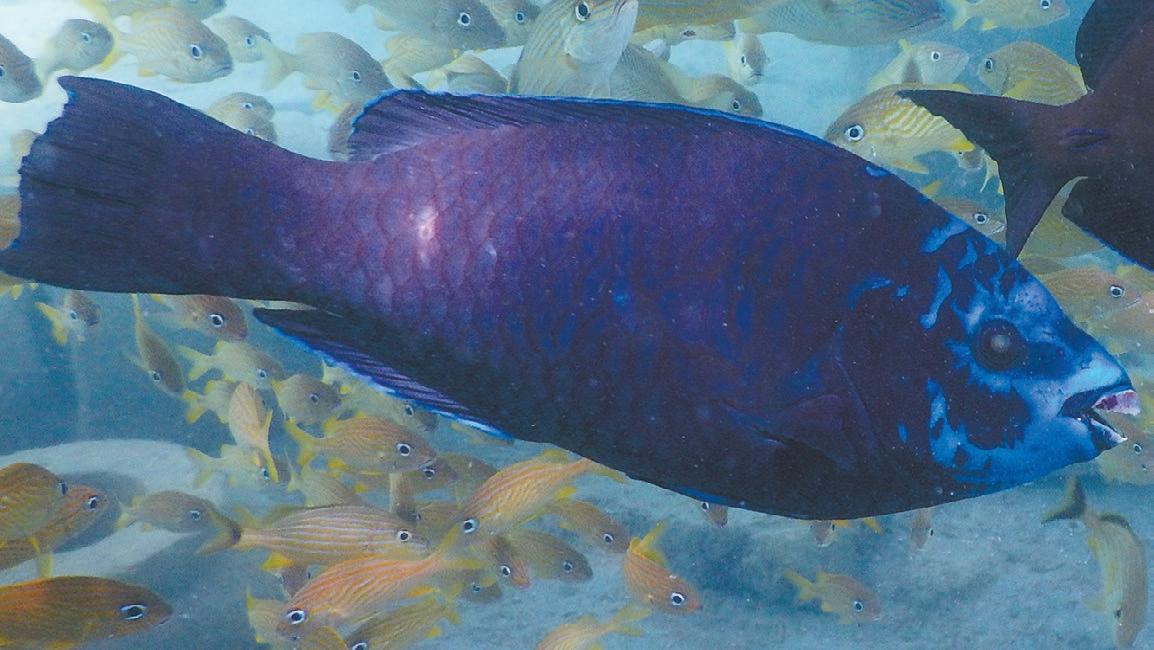
When it comes to feeding, midnight parrotfishes are primarily herbivorous, but evidence has shown that they also love to treat themselves to the eggs of sergeant major damselfish (Abudefduf saxatilis). They seem to love it so much that they even school with up to 30 other individuals to overwhelm the typically heavily guarded damselfish nests. Bite scars indicate that this is not an uncommon behavior.
—Continued on next page
MARIGOT BEACH CLUB

Marigot Bay, 00123 Marigot Bay Saint Lucia
OPENING TIMES FOR RESTAURANT 7AM-11PM Daily
Ferry operates from 7AM-11PM Daily
MEAL TIMES
Breakfast: 8AM-10:30AM
Lunch: 11:30AM-5:30PM
Dinner: 6:30PM-9:30PM
Bar opens till 11:00PM
Happy Hour Daily from 5PM-6PM (2 drinks for the price of one on selected drinks, beers, wines, gins, rums, cocktails, rum punch, vodkas, etc.).
Outside Patrons who spend US15.00 or more, per person, at the restaurant or bar will have access to the resort facilities, such as the pool, sun loungers & complimentary Wi-Fi. Reservations are recommended, however walk-in customers will be accommodated as well.

Call 1 (758) 451-4974 or email us info@marigotbeachclub.com. We can also be reached via Instagram @marigotbeachclub @doolittlesrestaurantandbar

RESTAURANT DAILY SPECIALS

Indian Cuisine Special every Sunday evening
Thai Cuisine Special every Thursday evening
Sushi Special every Friday evening
BBQ Night Special every Saturday evening
RESORT OFFICE HOURS
Sunday-Saturday 7AM-11PM
To Book your resort stay please send inquire to info@marigotbeachclub. com . We can also be reached via Instagram @marigotbeachclub or visit our web page www.marigotbeachclub.com

AUGUST / SEPTEMBER 20 23 CARIBBEAN COMPASS PAGE 34
Midnight parrotfish
Continued from previous page


The fact that such large fish have to band together to overwhelm a tiny damselfish is to me testament of the feistiness of those arrogant little fish.
My most recent parrotfish observation has been the rainbow parrotfish (Scarus guacamaia) in the Florida Keys, moving in a small group, hugging the mangroves. They are very distinctive in coloration, but not as colorful as you would expect considering their common name. That, however, does not detract from their beauty; their front part is dressed in hues of brown-orange and the rear portion in green ending in a reddish to bronze tail with long tips (like the midnight parrotfish, both sexes have the same coloration). This beauty is among the largest of its family members, reaching respectable lengths of 1.2 m or 4 feet and can weigh in at 20 kg or 44 pounds.
These sociable fish can sometimes be seen patrolling the reef in maledominated aggregations of up to 40. They depend on both mangrove and coral reef habitats to complete their life cycle. Their juveniles rely on mangroves for food and safety before venturing out to adjacent coral reefs. The continued loss of mangrove habitats, combined with overfishing, has placed this species in a vulnerable situation, resulting in them being listed as near threatened on the IUCN red list of threatened species. Many Caribbean countries have already made positive steps in not only protecting this species, but all parrotfish species, considering their key role in promoting coral health.
It is clear that parrotfish are not only beautiful but unique, with intriguing habits. So next time you encounter one of these stunning fish, you will appreciate that there is more going on than good looks, as they scour the reef with their routine comings and goings.

AUGUST / SEPTEMBER 20 23 CARIBBEAN COMPASS PAGE 35
HEY,
Visit our website at caribbeancompass.com or just scan the QR code BELOW and enter your email address — it’s as easy as that!
Rainbow parrotfish
READERS!
CALENDAR
August 2023
Jul 28-Aug 11 Emancipation Festival, BVI (parade Aug 7). bvitourism.com/events/bvi-69th-emancipation-festival-23
1 Public holiday in many places (Emancipation Day)
1 FULL MOON
1 Full Moon Party, Trellis Bay Market, BVI trellisbaymarket.com/fullmoonparty
1 Jambalasee Festival, a celebration of Grenada’s Jab Jab culture, St. Andrew. puregrenada.com/events/jambalasee-festival-2
1 - 15 Grenada Carnival, ‘SpiceMas.’ spicemasgrenada.com
3 Bermuda Cup Match Cricket Festival. caribbeanevents.com/event/bermuda-cup-match-cricket-festival
3 - 4 St. John Festival, St. John, USVI
4 – 7 Carriacou Regatta. puregrenada.com
5 Breadfruit Festival, St. Vincent and Grenadines. caribbeanevents.com/event/breadfruit-festival
3 – 13 Anguilla Summer Festival. facebook.com/officialaxasummerfestival
7-14 Barbados Carnival ‘Crop Over/Grand Kadooment.’ visitbarbados.org
7 – 8 Antigua Carnival
7 – 9 BVI Emancipation Festival, Tortola
8 Nevis Carnival ‘Culturama.’ nationaltoday.com/culturama-day
9 Belize Carnival. caribbeanevents.com/event/belize-carnival
11 World Steelpan Day
12 Leeward Island Calypso Competition, Anguilla.
16 Dominican Restoration Day, Dominican Republic.
24 Fête de Saint-Bartelemy. Boat races in Gustavia
25 – 27 Aruba Regatta. aruba-regatta.org
27 – Sep 4 Scrub Island Billfish Invitational Fishing Tournament, BVI. bvitourism.com/events/scrub-island-billfish-invitational
30 La Rose Flower Festival, St. Lucia
31 Public holiday in Trinidad & Tobago (Independence Day)
31 FULL MOON
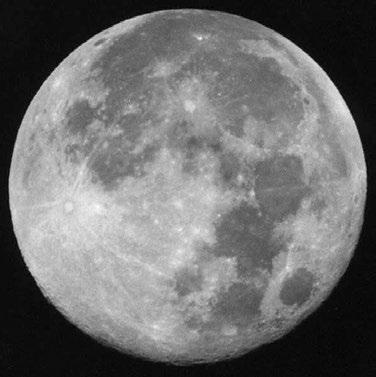
1 Full Moon Party, Trellis Bay Market, BVI trellisbaymarket.com/fullmoonparty
TBA Start of weekly fishingboat races, Cap Haitien, Haiti. haitisailingcup.com
September 2023
4 Public holiday in Puerto Rico and USVI (Labor Day)
6 Public holiday in Bonaire (National Day)
16 Public holiday in St. Kitts & Nevis (National Heroes Day)
16 – 17 Back to School Regatta, BVI. caribbean-sailing.com/event/back-to-school-regatta-6
16 – 23 St. Lucia Dive Fest, St. Lucia
19 Public holiday in St. Kitts & Nevis (Independence Day)
23 Autumnal Equinox
24 Public holiday in Trinidad & Tobago (Republic Day)
29 FULL MOON
29 Full Moon Party, Trellis Bay Market, BVI trellisbaymarket.com/fullmoonparty
All information was correct to the best of our knowledge at the time this issue of Compass went to press — but plans change, so please contact event organizers directly for confirmation.
If you organize a sailing or boating event not listed here that you’d like to have included in our monthly calendars, please send information two months before the event date(s) to editor@caribbeancompass.com
TRINIDAD Budget Marine
C3 Marina Caribbean Marine Electrical
Coral Cove Marina office/ Corner Post/ Hardware
Crews Inn Hotel
Customs office
Dynamite Yacht Management Services
Echo Marine
Immigration office
Marc One Marine Supplies
Members Only - Maxi Taxi Service
Peake’s Trading/ Restaurant/ Chandlery
Power Boats office/ Restaurant/ Grocery
Sweet Water Marina
Tropical Marine office
TTSA
YSATT office
COLOMBIA
Marina Santa Marta
MERIDIAN PASSAGE OF THE MOON
Crossing
moon for the months of August
September,
help
tides. Water generally tries to run toward the moon. The flood tide starts running eastward soon after moonrise, continues to run east until about an hour after the moon reaches its zenith (see TIME below) and then ebbs westward. From just after the moon’s setting to just after its nadir, the tide runs eastward; and from just after its nadir to soon after its rising, the tide runs westward. The first hour after moonrise, the westerly current is barely negated. The second hour the flood tide is stronger, the third and fourth hour it’s strongest, then it eases off in the fifth and sixth hours. The maximum tide is three or four days after the new and full moons.
AUGUST / SEPTEMBER 20 23 CARIBBEAN COMPASS PAGE 36
the channels between Eastern Caribbean islands, an ebb tide carries you off to leeward and a strong flood tide creates lumpy seas, so crossing with a favorable tide is faster and more comfortable. The table below, showing the local time of the meridian passage (or zenith) of the
and
will
you calculate the
AUGUST & SEPTEMBER 2023 PICK UP!
August 2023 DATE TIME 1 0000 FULL MOON 2 0027 3 0125 4 0219 5 0310 6 0358 7 0446 8 0534 9 0624 10 0715 11 0808 12 0901 13 0953 14 1043 15 1131 16 1215 17 1257 18 1338 19 1417 20 1457 21 1538 22 1621 23 1709 24 1801 25 1858 26 1959 27 2103 28 2206 29 2306 30 0000 FULL MOON 31 0003 September 2023 1 0056 2 0147 3 0236 4 0326 5 0417 6 0509 7 0602 8 0656 9 0749 10 0840 11 0928 12 1014 13 1056 14 1137 15 1217 16 1257 17 1337 18 1420 19 1506 20 1555 21 1650 22 1748 23 1849 24 1951 25 2050 26 2147 27 2241 28 2332 39 0000 FULL MOON 30 0022
Ahoy, Compass readers! When in Trinidad and Colombia, pick up your free copy of the Caribbean Compass at any of these locations (advertisers in bold):
Caribbean Compass Market Place
MID ATLANTIC YACHT SERVICES
PT-9900-144 HORTA / FAIAL, AZORES
Providing all vital services to Trans-Atlantic Yachts!
Incl. Chandlery, Charts, Pilots, Rigging EU-VAT (18%) importation
Duty free fuel (+10.000lt)
TEL +351 292 391616 FAX +351 292 391656 mays@mail.telepac.pt www.midatlanticyachtservices.com


Grenada
Azores Saint Kitts & Nevis SVG SVG
NEILPRYDE Sails Grenada
Check out our website or contact us directly for a competitive quote on rugged and well-built sails that are well suited to the harsh environment of the charter trade and blue water cruising.
Jeff Fisher – Grenada (473) 407 6355 www.neilprydesails.com

WE OFFER:
• Grocery Shopping / Personal pick-up (with delivery to your dock)
• Argyle International Airport direct shuttle (starting from EC$30)

• Bill payments
LAC Services App (Google App Store) Tel: (784) 527-3082, (784) 492-9983 E-mail: lacservices@lacsvg.com
GRENADINES SAILS & CANVAS • BEQUIA •
NEW SAILS, SAIL REPAIRS, U/V COVERS FOAM LUFFS, BIMINI, DODGERS AWNINGS, DINGHY COVERS, UPHOLSTERY TRAMPOLINES, STACKPACKS & LAZY JACK SYSTEMS

BEST CUSTOM-MADE DINGHY CHAPS
Located northern side of Admiralty Bay Tel (784) 457-3507 / 457-3527 (evenings) gsailsbequia@gmail.com VHF Ch16/68



Trinidad THIS COULD BE YOUR MARKET PLACE AD

shellese@caribbeancompass.com

AUGUST / SEPTEMBER 20 23 CARIBBEAN COMPASS PAGE 37 continued on next page
THAT CARRIACOU LIFE

Rise with the sun.
Lean into the morning music
Birds are tambourines.
The soft rain is a sitar.
Have a bowl of callaloo with the elders.
Place your shoes at the door.


Plant your herbs.
Let your laundry dry in the breeze.


See Shakespeare Mas at Mt. Royal. Meet a Hero.
Eat lobster at Cashmere’s

Take a nap.
Sip a Carib.
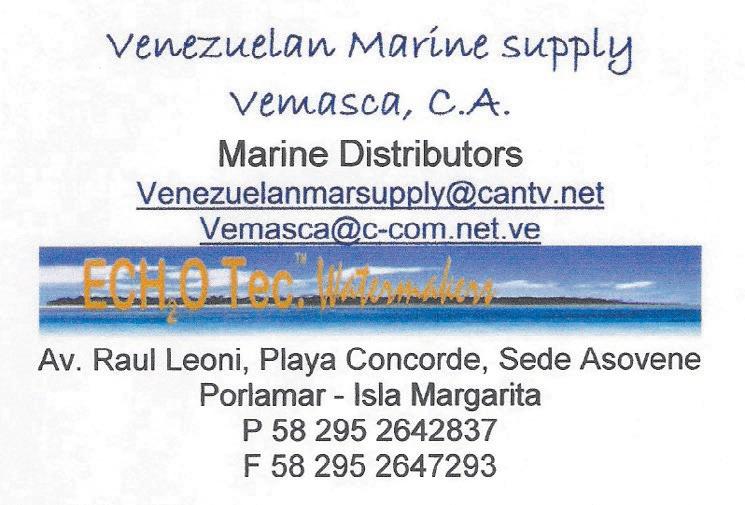
Swim under the midnight moon.

Follow the rhythm of your own drum.


Pay kings and queens no mind. Your only monarch is the sea.

Island Poets

Editor’s note: Rashidah Shakir-Blackshere is an English teacher and founder of the theatrical event "Shakespeare on the Green" at Los Angeles Trade-Technical College.

AUGUST / SEPTEMBER 20 23 CARIBBEAN COMPASS PAGE 38 Real Estate Market
Venezuela LIVE THE DREAM FOR SALE OURCARRIACOU.COM/WOW CARRIACOU REAL ESTATE Land and houses for sale For full details see our website: www.carriacou.net Contact: islander@spiceisle.com Tel: (473) 443 8187 Caribbean-wide McINTYRE BROS. LTD. True Blue, St George’s Grenada Call 1 (473) 444 3944 macford@spiceisle.com Honda, Mazda and Ford Dealership Vehicle Sales & Service Book your Car rentals & Island Tours with us Discover Grenada with Caribbean Horizons Tours & Services info@caribbeanhorizons.com www.caribbeanhorizons.com 2 & 4-Stroke Engines Genuine Parts & Service Yamaha Certified Technicians Duty free deliveries & reliable service for Yachts GRENADA Click here to read a sample or to order: https://amzn.to/2ZaLfzw Trinidad HEY,
Visit our website at caribbeancompass.com or just scan the QR code BELOW and enter your email address — it’s as easy as that!
Place Cont.
READERS!
— Rashidah Shakir-Blackshere
DIGITAL PAINTING BY TAD RICHARDS
FOR SALE

BEQUIA, LAWLER HILL Over 2 acres of mature grounds with fabulous views overlooking Port Elizabeth, Lower Bay, Friendship Bay and Mustique. Property includes a charming home plus a cottage hideaway. Could be sold separately or together. Price negotiable. Contact T. M. Zoffoli, Tel: (774) 563-0240 E-mail: austintiare860@gmail.com
BEQUIA - ISLAND PACE REAL ESTATE 43,560 sq/ft + acre lots, Ocean Ridge estates, North Bequia. US$100,000 & up, US$2.50/ sq/ft & up. Tel: (784) 493-4711 E-mail: emmett@islandpace.com



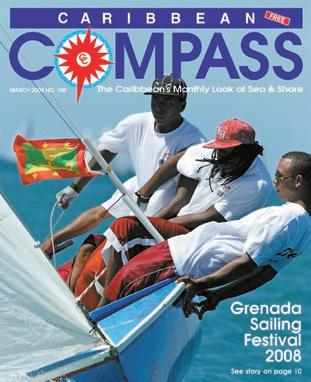


AUGUST / SEPTEMBER 20 23 CARIBBEAN COMPASS PAGE 39 ADVERTISER LOCATION PG# ADVERTISER LOCATION PG# ADVERTISER LOCATION PG# ADVERTISER LOCATION PG# Art Fabrik Grenada MP Bequia ThreadWorks SVG MP Blue Lagoon Hotel & Marina SVG 6 Boat Paint & Composites St. Maarten 20 Budget Marine St. Maarten 2 Budget Marine St. Kitts St. Kitts MP Caribbean Airlines C/W 5 Caribbean Multihull Challenge St. Maarten 7 Carriacou Business Grenada MP Centenario & Co Panama 18 Clarkes Court Grenada 23 Club De Pesca Marina Colombia 18 Dolphin Water Taxi St. Thomas 17 Douglas Yacht Services Martinique 10 Down Island Real Estate Grenada MP Doyle Offshore Sails Barbados 12 Doyle's Guides USA 20 Grenada Marine Grenada 31 Grenadines Sails SVG MP Grupo Pelicano Culebra Puerto Rico 29 Happy Kite SVG MP Horizon Yacht Charters Grenada 35 Hutch's E-book C/W 38 Hydrovane International Marine C/W MP Island Water World Sint Maarten 40 LAC Services SVG MP Mac's Pizzeria SVG MP Marigot Beach Club St. Lucia 34 Marina Santa Marta Colombia 25 McIntyre Bros Grenada 38 Mid Atlantic Yacht Services Azores MP Ministry of Trade & Industry Trinidad 15 Neil Pryde Sails Grenada MP Northern Lights- Parts & Power Tortola 13 Off Shore Risk Management Tortola 26 Peake Yacht Services Trinidad 9 Power Boats Trinidad MP Sailors for the Sea C/W 21 Spice Island Marine Grenada 32 St. Lucia Tourism Authority St. Lucia 27 Tobago Cays SVG MP Turbulence Sails Grenada 26/MP Umbrellas Beach Bar Grenada 8 Venezuelan Marine Supply Venezuela MP Westerhall Rum Grenada 23 WhitCo Insurance USA 12 YSATT Trinidad MP ADVERTISERS INDEX MP = Market Place pages 37 - 38 C/W = Caribbean-wide DON‘T LEAVE PORT WITHOUT IT CLASSIFIEDS CLASSIFIEDS US 50¢ PER WORD Include name, address and numbers in count. Line drawings/photos accompanying classifieds are US$10. Pre-paid by the 10th of the month: E-mail: shellese@caribbeancompass.com HEY READERS, GET CARIBBEAN COMPASS BY EMAIL! Visit our website at caribbeancompass.com or just scan the QR code BELOW and enter your email address — it’s as easy as that! PROPERTY

Published by Compass Publishing LLC, Connecticut, USA, and printed by Guardian Media Limited, Trinidad & Tobago
























































































































































